

Back to basics
United Way Maritimes’
CEO Sara Napier, and a powerful group of other corporate leaders, are delivering new fixes for the nation’s food insecurity crisis
How to handle polarized topics effectively
PAGE 13
Bill Morneau and Jaime Watt on turning uncertainty into opportunity
PAGE 15
Meet ICD’s new chair
Tom Woods
PAGE 18
JANUARY/ FEBRUARY 2025
18
A
thirst for knowledge
ICD’s new chair Tom Woods continues to seek insight, even as he serves at the pinnacle of North American banking
24 When donations aren’t enough
Food banks are working with companies to try to do more than feed the hungry. They want social change
34 Courageous boards
It takes courage to speak up, and to know when not to lean into an issue
42 Indecision time
Uncertainty hurts your business, especially when it leads to paralysis




Departments
5 EDITOR’S NOTE
6 CEO INSIGHTS
7 HAPPENINGS
Coming together in Newfoundland and the Maritimes, governing AI in Saskatchewan, expanding Indigenous partnerships in Calgary, congratulating the 2025 Fellows, and board appointments
10 DISPATCHES
Beware the “gate louse,” in with the new directors, resetting expectations, boardroom friendships, more vigilance inside the banks, and tracking director hours
13 POINT OF VIEW
Polarization in the boardroom will hinder informed decision-making
15 DIRECTORS’ DILEMMA
Can you turn political uncertainty into opportunity?
48 RECOMMENDED READING
In Home Truths: Fixing Canada’s Housing Crisis, Carolyn Whitzman finds better solutions abroad
50 ADJOURNED
Like father, like son the Trudeaus have had rocky relations across the border
EDITOR
Simon Avery
ART DIRECTION + DESIGN
Steven Balaban, Philina Chan
INSTITUTE OF CORPORATE DIRECTORS
Rahul Bhardwaj, President and CEO
Richard Piticco, Chief Administrative Officer
Jan Daly Mollenhauer, Vice-President, Sales Marketing, Membership
Gigi Dawe, Vice-President, Policy & Research
Shannon Hunt, Vice-President, Education
Kathryn Wakefield, Vice-President, Chapter Relations
SJC
Tony Gagliano, Chair and CEO
Cameron Williamson, Vice-President Client Solutions, Media & Content
Sasha Emmons, Vice-President, Branded & Custom Content
Paul Ferriss, Director, Editorial & Creative
Joycelyn Tran, Production Manager
ADVERTISING INQUIRIES
For advertising inquiries, please contact Christine Miles, Director, Sponsorship, cmiles@icd.ca
Building trust and confidence in Canadian organizations is imperative. At the Institute of Corporate Directors (ICD), we believe that this starts with the right leadership and good governance. Directors must lead by being informed, prepared, ethical, connected, courageous and engaged with the world. In the pages that follow, you will find thoughtful and provocative articles that explore these essential leadership qualities.
Bâtir la confiance envers les organisations canadiennes est primordial. À l’Institut des administrateurs de sociétés (IAS), nous croyons que cela commence par un bon leadership et une bonne gouvernance. Les administrateurs doivent gouverner en étant informés, préparés, intègres, connectés, courageux et ouverts sur le monde. Dans les pages qui suivent, vous trouverez des articles réfléchis et provocateurs qui explorent ces qualités de leadership essentielles.
1601 – 250 Yonge Street, Toronto, Ontario M5B 2L7
T: 416-593-7741 F: 416-593-0636 E: info@icd.ca
ISSN 2371-5634 (Print)
www.icd.ca ISSN 2371-5650 (Online)
The ICD welcomes a diversity of opinion for inclusion in Director Journal. The contents of this publication do not necessarily reflect the opinions of the ICD, its partners, its sponsors, or its advertisers. Readers are encouraged to consider seeking professional advice and other views.
To request reprints of articles, please contact info@icd.ca

Simon Avery Editor savery@icd.ca
Forging ahead
It’s a tough time to make big decisions, but standing still isn’t an option
When should you stay the course and when is it time to change the plan? It’s a question on the minds of many board members these days as they survey the unstable landscape around them. The tectonic economic, political and technological shifts occurring give the most confident of leaders reason for pause.
Boards may be tempted to hold off on strategic decisions until they know more about the Trump administration’s protectionist agenda, and until Canadian voters have had their say on the next prime minster. But as our feature on tough decision-making explains (page 42), too much indecisiveness is bad for business. Whether the dilemma is about investing in AI or expanding internationally, it’s important to at least begin the process now.
Some areas of our society present a clearer picture. Our cover story (page 24) talks to people combatting food insecurity. As they collect staggering amounts of supplies to serve record numbers of foodbank clients, it’s become clear to most involved that donations on their own won’t solve the problem. Not-forprofits and corporate leaders are calling for changes in social policies. The need is apparent to anyone who looks at the rising numbers and listens to the individual stories.
Whether the pathway forward is obvious or not, often the decision to take it demands courage, especially in today’s polarized world where critics can amplify their opposition on social media. Our feature “Finding the courage to speak” (page 34), discusses steps directors should consider before taking a public position on business or social issues. One of the most important is to make sure that the board has the right perspectives in the room to ensure that directors are able to evaluate the relevant risks and opportunities. In essence, good decisions and strategies require wisdom. The profile of Tom Woods, the ICD’s new chair, spotlights his continuing quest for knowledge, even after he has scaled the heights of the business and governance worlds. In demanding periods such as today’s, a passion for learning seems like a good basis for success.
Aller de l’avant
C’est un moment difficile pour prendre des décisions importantes, mais l’immobilité n’est toujours pas une option
Quand faut-il garder le cap et quand est-il temps de changer de plan? Voilà une question qui flotte dans l’esprit de beaucoup d’administrateurs par les temps qui courent, au moment où ils observent le monde instable qui les entoure. Les plaques tectoniques d’ordre économique, politique et technologique qui se heurtent donnent aux leaders les plus confiants des raisons de prendre une pause.
Les conseils peuvent être tentés de suspendre des décisions stratégiques importantes jusqu’à ce qu’ils en sachent plus sur l’ordre du jour protectionniste de l’administration Trump et jusqu’à ce que les électeurs canadiens se soient exprimés sur l’identité du prochain premier ministre. Mais comme l’explique notre article sur la prise de décisions difficiles (page 42), trop d’indécision est mauvais pour les affaires. Que le dilemme touche l’investissement en IA ou une expansion internationale, il est important d’au moins entreprendre le processus maintenant.
Certaines zones de notre paysage social offrent une image beaucoup plus claire. Notre article de couverture (page 24) traite de certaines personnes qui combattent l’insécurité alimentaire dans différentes régions du pays. Alors qu’ils recueillent des volumes impressionnants de provisions pour servir des nombres records de clients des banques alimentaires, il est devenu évident pour la plupart des gens impliqués que les dons seuls ne résoudront pas le problème. Les organismes à but non lucratif et les leaders d’affaires réclament des changements aux politiques sociales. La nécessité saute aux yeux de quiconque regarde les chiffres croissants et écoute les récits individuels.
Que la marche à suivre soit évidente ou non, il arrive souvent que la décision de l’emprunter exige du courage, en particulier dans un monde polarisé où les critiques peuvent amplifier leur opposition par le biais des médias sociaux. Notre article « Trouver le courage de parler » (page 34) évoque les étapes que les administrateurs devraient envisager avant de prendre position sur des enjeux d’affaires ou sociaux. L’un des gestes les plus importants consiste à s’assurer que le conseil adopte les bonnes perspectives afin de faire en sorte que les administrateurs soient en mesure d’évaluer tous les risques pertinents et les opportunités. En substance, les bonnes décisions et les bonnes stratégies requièrent de la sagesse. En page 18, le profil de Tom Woods, le nouveau président du conseil de l’Institut des administrateurs de sociétés, raconte l’intéressant parcours d’un homme en quête perpétuelle de connaissances, même après avoir occupé les sommets du monde des affaires et de la gouvernance. Dans des périodes exigeantes comme celle que nous connaissons, la passion de l’apprentissage représente une bonne condition de réussite.
Buckle up
Directors can expect to be front and centre as Canada confronts new challenges
Between the wildfires in the United States, the consequent conversations about climate change, the pushback on DEI, and, of course, the prospect of tariffs, we have experienced a dynamic and uncertain start to the year. Canadian directors can add to this list the uncertainty arising from a change in prime ministers, a federal election and new inter-provincial pressures.
In short, this will be a year like no other for board directors. On top of these challenges, global political and economic forces will raise the spectre of trust in ways we haven’t seen. As trust is the lifeblood of good governance, directors are going to find themselves in the spotlight. The situation reminds me of an old adage about the difference between management and leadership: Where management is about doing things right, leadership is about doing the right things. Directors’ leadership is more important now than ever.
Even with these sizeable challenges in front of us, I remain optimistic. Whenever I speak to my international colleagues, they convey their respect for how Canada has built such a large and strong community of directors. This strength speaks to the commitment of our directors, to their own stewardship, and to their continuous learning and sharing among their peers. It also provides a credible foundation to be able to say that it’s time to make corporate governance Canada’s global competitive advantage.
At the ICD, we’re here to help you make that happen, starting with our national conference in Edmonton from June 3 to 4. Entitled “Today’s board: Resilient by design,” the event will emphasize how directors can have the greatest effect by being adaptive, bold and intentional. And, with these characteristics in mind, it’s a pleasure to welcome Dexter John as the newest member of the ICD’s board, and Tom Woods as our new board chair. Tom brings a wealth of knowledge from the banking sector as well as extensive board service. You can read more about his background and outlook in the profile beginning on page 18.

Rahul Bhardwaj, LL.B, ICD.D President and CEO, The Institute of Corporate Directors
Bouclez vos ceintures
Les administrateurs peuvent s’attendre à jouer un rôle de premier plan au moment où le Canada fait face à de nouveaux défis
Entre les Incendies aux États-Unis, les conversations qui en résultent concernant les changements climatiques, les reculs des DEI et, bien sûr, la perspective des tarifs, nous avons connu un début d’année mouvementé et incertain. Les administrateurs canadiens peuvent ajouter à cette liste l‘incertitude découlant du changement de premiers ministres, d’une élection fédérale et de nouvelles pressions interprovinciales.
En somme, ce sera une année comme nulle autre pour les administrateurs. En plus de ces défis, les forces politiques et économiques mondiales vont réveiller le spectre de la confiance de façon inédite. Comme la confiance est le moteur de la bonne gouvernance, les membres des conseils vont se retrouver sous les projecteurs. La situation me rappelle un vieil adage sur la différence entre la gestion et le leadership : alors que la gestion consiste à bien faire les choses, le leadership consiste à faire les bonnes choses. Le leadership des administrateurs est plus important que jamais.
Même malgré les défis considérables qui se posent à nous, je demeure optimiste. Chaque fois que je discute avec mes collègues internationaux, ils expriment leur respect envers la façon dont le Canada su bâtir une communauté d’administrateurs vaste et forte. Cette force traduit l’engagement de nos administrateurs, la qualité de leur intendance ainsi que leur apprentissage continu et leur partage entre pairs. Elle offre aussi un fondement crédible pour affirmer qu’il est temps de faire de la gouvernance de sociétés un avantage concurrentiel mondial pour le Canada.
À l’IAS, nous sommes là pour vous aider à le réaliser, à commencer par la tenue de notre congrès national qui se tiendra à Edmonton les 3 et 4 juin. Sous le thème « La résilience au cœur du conseil d’aujourd’hui », l’événement soulignera comment les administrateurs peuvent obtenir les meilleurs résultats en s’adaptant et en faisant preuve d’audace et de résolution. Et avec ces traits particuliers à l’esprit, c’est avec plaisir que nous accueillons Dexter John à titre de nouveau membre du conseil de l’IAS et de Tom Woods, nouveau président du conseil, qui apporte avec lui une connaissance approfondie du secteur bancaire. Vous pourrez en savoir plus sur son parcours et ses perspectives en lisant son profil en page 18.
PHOTO: BRIANNA ROYE.
Happenings

MARITIMES & NEWFOUNDLAND CHAPTERS
Joining Forces for Greater Impact: A Board’s Perspective
The Maritimes and Newfoundland Chapters recently hosted a collaborative event on how boards can enhance their impact by joining forces. The discussion centred on the importance of strategic collaboration across various sectors to address challenges, innovate, and drive sustainable growth. Panelists shared real-world examples of successful board partnerships that have led to significant organizational change. Our audiences heard from Alfred Arsenault, CEO of Provincial Credit Union, Sara Napier, ICD.D, President & CEO of United Way Maritimes, and Robert MacDonald, President & CEO of Lung NS PEI. Haley Ha, Shared Services Navigator from Community Services Network, moderated the session.
ICD members are invited to participate in upcoming events hosted by ICD National and local ICD Chapters. Join an upcoming ICD virtual or in-person event
+ RECENT CHAPTER EVENTS
+ EDUCATION SPOTLIGHT
+ DIRECTORS ON THE MOVE

SASKATCHEWAN CHAPTER
The Board’s Role in Governing
AI
At a recent event, the Saskatchewan chapter focused on boards’ critical role in overseeing AI governance. Discussions concerned directors’ responsibilities in understanding AI technologies, managing risks, and ensuring that AI initiatives align with their organization’s strategic goals. Bill Bishop, CEO of The BIG Idea Company was the event expert. He shared best practices for keeping boards informed and engaging with evolving AI trends. The event was moderated by Collin Pullar, ICD.D, President of the Saskatchewan Construction Safety Association.
CALGARY CHAPTER
Expanding Benefits of Indigenous Partnerships Beyond Energy and Natural Resources
At a recent Calgary chapter event, leaders gathered to explore how Indigenous partnerships are increasingly extending beyond the energy and natural resources sectors. The panel discussed the growing potential for boards to engage in impactful collaborations that contribute to long-term social and economic development. Panellists included W. Sean Willy, Board member at Telus; Chana Martineau, ICD.D, CEO of Alberta Indigenous Opportunities Corporation (AIOC); and Mark Podlasly, ICD.D, Sustainability Officer at the First Nations Major Projects Coalition, a CIBC Board Director, and a Hydro One Board Director. Billie Fortier of MLT Aikins LLP led this insightful discussion.

SAVE THE DATE: JUNE 3 AND 4, 2025
‘Resilience is critical’
Registration for the ICD National Director Conference and Fellowship Awards Gala in Edmonton on June 3 and 4 is still open. This year’s event, Today’s board: Resilient by design, is co-chaired by directors Jim Carter, Alice Laberge and Irfhan Rawji. The conference will explore how boards can develop resilience in an increasingly volatile environment. Jim Carter, F.ICD, shares his thoughts: “The ICD Conference is a much-anticipated annual platform for directors across Canada to share solutions to the challenges of modern day directorship, as well as strategies for boards to optimize opportunities.” Don’t miss the chance to connect with fellow directors and celebrate excellence in governance at the Fellowship Awards Gala.



F.ICD ANNOUNCEMENT
Congratulations to the 2025 ICD Fellows Honourees
Mary Cameron, ICD.D
Hubert T. Lacroix, BCL, ICD.D
Real Raymond
Kate Stevenson, ICD.D
Each will be awarded the prestigious F.ICD designation, recognizing their outstanding contributions to governance and leadership in the boardroom. This distinction is a testament to their commitment to excellence in corporate governance and dedication to enhancing board effectiveness. The ICD celebrates their success and look forward to the continued impact they will make in shaping Canada’s governance landscape.
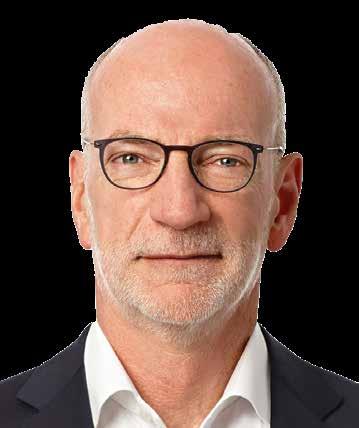
Register now for the 2025 ICD National Director Conference and Fellowship Awards Gala in Edmonton.
The Fellowship Awards Gala will honour the 2025 ICD Fellows, recognized for their outstanding contributions to board governance leadership.
DIRECTORS ON THE MOVE
The ICD would like to congratulate the following members on their recent board appointments:
TECHNOLOGY
Garry M. Foster, ICD.D INDEPENDENT CHAIRMAN Real Matters Inc.
Kristi Honey, ICD.D DIRECTOR Tantalus Systems Holding Inc.
BANKING & FINANCIAL SERVICES
Rita Parikh, ICD.D CHAIR
Vancity Community Investment Bank
METALS & MINING
Terry Krepiakevich, ICD.D DIRECTOR Soma Gold Corp.
Ken Robertson, ICD.D DIRECTOR Uranium Royalty Corp.
TRANSPORTATION
Darlene Hyde, ICD.D DIRECTOR TransLink
INDUSTRIAL
Ave Lethbridge, ICD.D DIRECTOR Toromont Industries Ltd.
INSURANCE
Claude Delage, ICD.D DIRECTOR AGA Benefit Solutions
Christine Wellenreiter, ICD.D DIRECTOR MutualOne Insurance Co.
ENERGY & POWER
Cynthia Johnston, ICD.D DIRECTOR Eavor Technologies Inc.
PROFESSIONAL SERVICES
Rob Brouwer, ICD.D BOARD CHAIR KPMG Middle East
BUILDING & CONSTRUCTION
Sandy Blue, ICD.D CHAIRPERSON UFV Properties Trust
NOT-FOR-PROFIT
Cherise Arnesen, ICD.D ADVISORY BOARD Real Estate Insurance Exchange
Adam Dodek, ICD.D CHAIR
Canadian Legal Information Institute
Jennifer Coulson, ICD.D DIRECTOR Science World
Derek Lothian, ICD.D DIRECTOR Vineland Research and Innovation Centre.
Chris Lane, ICD.D DIRECTOR Saskatchewan Country Music Association
Jack Graham, ICD.D CO-CHAIR International Tennis Federation Licensing
Grant Sprague, ICD.D DIRECTOR Enserva
Daniel Fontaine, ICD.D DIRECTOR Hockey Canada
Ellen Corkery-Dooher, ICD.D DIRECTOR Youth Services Bureau of Ottawa
Katherine Hay, ICD.D DIRECTOR Mental Health Research Canada
Marni Dicker, ICD.D DIRECTOR CreateTO
Mark S, Bonham, ICD.D DIRECTOR CreateTO
Catherine Middleton, ICD.D DIRECTOR Council of Canadian Academies
Adrian de Saldanha, ICD.D DIRECTOR Partners Community Health
GOVERNMENT
Gervan Fearon, ICD.D DIRECTOR Royal Ontario Museum
Avanthi Goddard, ICD.D AUDIT COMMITTEE MEMBER Public Health Agency of Canada
Rita Andreone, ICD.D VICE CHAIR Prince Rupert Port Authority
Derek Vanstone, ICD.D DIRECTOR Ontario Cannabis Retail Corp.
Luana Comin-Sartor, ICD.D DIRECTOR Calgary TELUS Convention Centre
Send your board appointment publication requests to: Sheldon Mahabir, Director of Member Engagement, smahabir@icd.ca
Dispat hes

Cleaning up bank culture
TORONTO-DOMINION BANK sent shockwaves through the banking sector when it pleaded guilty last fall to a host of charges in a U.S. moneylaundering case, incurring a US$3-billion fine from U.S. officials. Prosecutors say the bank failed to detect suspicious activity for nearly a decade, and as a result it now faces years of restrictions on its U.S. operations. In January, TD overhauled its board and accelerated the planned departure of its CEO.
NEWSWORTHY TRENDS AND TOPICS FOR DILIGENT DIRECTORS
Canadian regulators say compliance is no longer just the job of chief compliance officers. Under new rules, everyone has to be responsible for spotting and addressing issues as soon as they arise. Executives and boards must take seriously the fact that they are accountable for corporate culture, the Office of the Superintendent of Financial Institutions says.
Written by RENÉE SYLVESTRE-WILLIAMS
WASH, RINSE, REPEAT
ALMOST PERFECT
Managing expectations
ONE OF THE BIGGEST OBSTACLES to effective leadership can be inflexibility. Some telltale signs that your high standards might be holding you back include: Missing deadlines, procrastinating because you’re waiting for the “perfect” moment to start a project, consistently working late to meet your own expectations, and team resentment. If you and your team aren’t in sync, don’t worry, you’re not alone. Here are four tips from the Harvard Business Review to help you adjust your expectations without sacrificing your success rate.

WELL TRAVELLED
Don’t be a ‘gate louse’
Pause
Take 15 to 30 minutes to step back and reflect on your goals. Are they aligned with your company’s mission? Have you communicated them clearly to your team?
Be flexible
Are your standards driving results, or are you keeping people late because you’re obsessed with perfection? Sometimes the best work happens when you let go of unnecessary ideals.
The culture fit
Are you the right fit for your current team, and is the company the right fit for you? No organization is perfect, but you might find more success elsewhere if the culture doesn’t align with your approach.
Engage in productive conflict
You don’t have to win every disagreement. Focus on finding common ground with your team rather than trying to win all the time. Sometimes compromise leads to better outcomes.
BUSINESS TRAVEL IS bouncing back after the pandemic, and for many, that means blending work with play for those increasingly popular “bleisure” trips. But even if your trip is all business, no one likes being stuck at the airport or in the middle seat on a plane. To make your trip as pain-free as possible, Bloomberg editors have compiled the best tools, tips, apps and guidelines to get you from point A to point B with minimal hassle.
There’s everything from getting a Global Entry expediated travel membership to the ideal boarding strategy (if you’re flying first class, your strategy is simple: Start with a nice dinner in the lounge, then head to your seat for a glass of champagne). But there’s one thing you’ll want to avoid: Being a gate louse — the person who crowds the gate before their boarding zone is even called. Yup, that’s what airline workers call them. Some “rules” might raise eyebrows. For example: Those who book the window seat control the shade, and whoever sits in the middle seat should get both armrests. You can decide for yourself if you agree.
DISPATCHES
FRIEND OR COLLEAGUE?
Too cozy in the boardroom?
WORKING TOGETHER forges friendships, but that’s not always a good thing when you’re close to the executives you have to oversee in your role as a corporate director. A recent settlement with the U.S. Securities and Exchange Commission found that “deep personal friendships” between board members and senior executives compromised the directors’ independence, making them ineffective at their governance duties.

Why does this matter? Because the best board dynamic occurs when leaders aren’t too cozy with each other. Directors must hold management accountable, not be beholden to them.
So, what counts as a “deep, personal friendship?” It’s usually obvious when there’s a romantic relationship, but what about the casual social friendships that often develop at work? Without a formal definition, it’s a good idea to work with your company’s general counsel and err on the side of disclosure. Better safe than sorry.
THE LATEST BDO Board Survey reveals that directors are focusing heavily on fraud prevention and detection in 2025. That includes reviewing compliance materials (43 per cent) and monitoring whistleblowing mechanisms (41 per cent). Directors are also assessing whether they are committing sufficient time to their board work to keep their organizations competitive. They’re dedicating about 285 hours to their most demanding board, with about one-third spent in meetings, another third on research, and the remainder connecting with people outside the boardroom.
Anti-aging strategy
IF YOU THINK BOARD MEMBERS are … seasoned, you’re right. A report from global asset manager AllianceBernstein Holding LP says that just 5 per cent of directors on S&P 500 companies are under the age of 50, with baby boomers making up nearly 70 per cent of the boardroom. The problem is that multigenerational boards are better for business.
Adding just one generation say, Gen Xers can lead to better financial outcomes, including stronger operating performance and higher returns on assets. Need more proof? The Tavistock Institute’s research found that age diversity enhances earnings reporting quality and reduces the amount of non-performing loans.
If your board is still stuck in a generational rut, it’s time to start thinking about the future. Start by bringing on some younger directors.
And what are they spending this time on? Governance and compliance are top of mind, with most directors seeing these issues as crucial for their companies’ growth — especially as we head into what’s expected to be a challenging economic climate.
Disrespect has no place in the boardroom
Beware of rhetoric that closes down debate, Gigi Dawe says
POLARIZATION COMMONPLACE in political arenas has become a significant challenge for businesses and corporate boards.
In recent years, society has grown more impervious to disrespectful rhetoric and bad behaviour. There was little attention paid a short time ago when a citizen approached and verbally attacked Canada’s Prime Minister. In the United States, many people publicly lauded last year’s murder of a health insurance executive by an angry citizen.
In its 2024 Global Risk Report, the World Economic Forum ranked societal polarization as the third greatest global risk for leaders and organizations over the next two years. The report suggests that society, governments, em ployees, consumers and shareholders, all of whom influence markets, are increasingly dividing into opposing groups.
Polarized politics can threaten the business environ ment when executives or directors allow their political beliefs to influence corporate decision-making. While it may seem positive when government policy supports your business purpose, it is seldom that simple.
For instance, the federal Liberal government imposes regulation and taxation to encourage climate action policies that are themselves polarizing. Yet, while any change in government that results in decreased regulation, taxes and policies might seem like a windfall for high-emission industries, it will not be without consequences. In addition to being an administrative burden, fluctuating regulations and taxation policies will increase uncertainty and unpredictability for companies on both sides of the climate issue.
If members of a board are entrenched in their own political or social views and aggressively communicate them to win a point, those members may be unwilling or unable to hear alternative views. That could very well result in toxic meetings and missed opportunities to make fully informed decisions in the best interests of the company.
Directors must acknowledge where they stand on issues that are likely to be polarizing and then approach their own and others’ views with a commitment to productive communication. This is not about homogeneity — a homogeneous view may also cause boards to take inappropriate risks or miss substantive opportunities based on their shared political leanings or personal beliefs. It is about hearing differing viewpoints, which is vital to making informed and considered decisions.
Gigi Dawe is the Institute of Corporate Directors’ vice-president of policy and research. She is a corporate governance and sustainability thought leader and educator for companies and individuals.
Emotionally charged or toxic discourse may also mute board members, or cause boards to sidestep politicized topics such as climate or social risks. Experience has taught many business leaders that avoiding confrontation can be an astute approach to decision-making. However, directors are expected to have a voice regardless of how negative the environment’s energy becomes, and an engaged board will make more informed decisions.
When polarization affects a company’s internal operations and plans, boards must pay particular attention to how the changes might affect corporate reputation and stakeholder relations.
It is natural for directors to hold divergent views on matters, fuelled by personal beliefs and experiences. When divisive and emotionally charged discourse makes its way into the boardroom, however, the ways in which individual directors manage themselves become paramount.
An overbearing discourse is not productive but, in the boardroom, silence is also not golden. Board members have been brought onto the board to share their expertise and perspectives, and the chair has an important role to facilitate that participation — by not engaging in aggressive language themselves, and calling it out when others do so.
Polarization is not a challenge that companies or their boards can ignore. While it can ebb and flow, it has become a pervasive force shaping today’s business landscape. When managed effectively, polarization can be used to enhance innovation and build a resilient company. However, when board members strongly maintain positions without question or validation and discredit others’ views, it can only compromise effective decision-making and the pursuit of long-term value for the company.

How can boards help turn political uncertainty into opportunity?
Bill Morneau
Bill Morneau is a former Canadian minister of finance and an experienced corporate director.
Bill Morneau est un ancien ministre canadien des Finances et administrateur de sociétés chevronné.
Canadian businesses are facing significant political uncertainty, whether from our upcoming national election (likely sooner than expected), from policies potentially enacted by the United States that could materially affect trade, or from conflicts and changes in political regimes around the world. To complicate matters, we could well see collisions between provincial and federal governments, adding another layer of considerations for business. If I’ve learned anything from my time in Ottawa, it’s that “nothing is ever certain.” Even outcomes that you think are sure bets are unpredictable.
Start with scenario analysis. Spend time thinking about the dimensions of relevant uncertainty that your organization is facing, beginning with a scenario analysis. For many Canadian businesses, the most significant dynamic emanates from south of the border. And that is coming both from policy initiatives by the Trump administration that are directly related to Canada, as well as policies that
Comment les conseils peuvent-
ils transformer l’incertitude politique
en opportunité?
Les entreprises canadiennes font face à une incertitude politique d’envergure, qu’il s’agisse de l’élection nationale à venir (plus tôt que tard), des politiques qui seront éventuellement adoptées par les États-Unis et pourraient affecter substantiellement le commerce ou encore des conflits et changements de régimes politiques dans le monde. Pour compliquer les choses, on pourrait voir se produire des accrochages entre gouvernements provinciaux et fédéral, ce qui ajouterait une couche supplémentaire de préoccupation pour les entreprises. S’il y a une chose que j’ai apprise de mon séjour

are not specifically directed at Canada but may have knock-on effects. A scenario analysis involves taking a particular policy and reviewing in detail the possible impacts on markets, clients, suppliers, competitors and employees. How would it affect your business, not just in the short term but longer term, if the duration of the policy is unknown? It’s worth remembering that the steel and aluminum tariffs imposed by the first Trump administration lasted almost a year. Of course, for many businesses, there are other elements of significant uncertainty. A possible new Canadian government in 2025 could lead to policy directions that present risk and opportunity. Mapping out the possibilities is necessary if any management team and board is to be prepared.
Increase engagement all around. Just as there will likely be more intensive engagement between Canada and the United States, and between Canada and other allies, amid dynamic policy shifts, I encourage Canadian businesses to also increase engagement with stakeholders.
→ Fine-tune your understanding of the issues. Work with management to ensure that the organization is in regular contact with governments, trade associations, suppliers and customers to better understand the dynamics. Considering multiple views will help in the development of a finer-tuned appreciation of what’s going on. This is an opportunity for board members to think about contacts they may have, and to lean into those.
→ Leverage influence of stakeholders. How can influencers be a part of a collaborative effort to deal with potentially negative policies? Using the example of tariffs, businesses should ask how they can support Canadian efforts to minimize the impact of those tariffs through any influence held by their suppliers, customers, employees and other industry contacts.
Consider the critical role of employees. Employers should consider increasing their engagement with employees, who might be unsettled by shifting political dynamics.
It goes without saying that 2025 could be an extremely challenging year. There is no substitute for the hard work of preparation.
à Ottawa, c’est que « rien n’est jamais certain ». Même les paris qu’on croyait gagnés d’avance demeurent imprévisibles. Voici mes conseils aux entreprises qui naviguent dans l’incertitude politique.
Commencer par une analyse de scénarios. Réfléchissez aux dimensions d’incertitude pertinentes à votre organisation, à commencer par une analyse de scénarios. Pour beaucoup d’entreprises canadiennes, la dynamique la plus importante émane du sud de la frontière. Cela concerne les initiatives politiques de l’administration Trump directement dirigées vers le Canada, mais qui peuvent aussi avoir des retombées indirectes. Une analyse de scénarios implique d’envisager une politique particulière et d’analyser en détail ses impacts potentiels sur vos marchés, vos clients, fournisseurs, concurrents et employés. Comment affecterat-elle votre entreprise, non seulement à court terme, mais aussi à plus longue échéance si la durée d’application de cette politique est inconnue? Il est bon de se rappeler que les tarifs imposés par la première administration Trump sur l’acier et l’aluminium a duré presque un an. Bien sûr, pour beaucoup d’entreprises, il y a d’autres éléments importants d’incertitude. L’élection d’un éventuel nouveau gouvernement canadien en 2025 pourrait mener à des directions politiques qui présentent des risques et des opportunités. Pour tout conseil et toute équipe de direction qui désire se préparer, il est nécessaire d’envisager les possibilités. Accroître l’engagement à tous les niveaux. Tout comme il y aura sans doute un engagement intensif entre le Canada et les États-Unis et entre le Canada et d’autres alliés au cœur de changements politiques dynamiques, j’encourage les entreprises canadiennes à accroître également leur engagement auprès des parties prenantes.
→ Affiner votre compréhension des enjeux. Travaillez avec vos équipes de direction pour faire en sorte que l’organisation demeure en contact régulier avec les gouvernements, associations d’entreprises, fournisseurs et clients afin de mieux comprendre les dynamiques en cours. Le fait d’envisager de multiples angles contribuera au développement d’une meilleure compréhension de ce qui se passe. Voilà une occasion pour les membres du conseil de recourir à leurs contacts.
→ Mettre à profit l’influence des parties prenantes. Comment les influenceurs peuvent-ils s’inscrire dans un effort collaboratif pour faire face à des politiques potentiellement négatives? En recourant par exemple à la question des tarifs, les entreprises pourraient leur demander comment ils peuvent soutenir les efforts du Canada pour minimiser l’impact de ces tarifs en jouant de l’influence de leurs fournisseurs, clients, employés et autres contacts au sein de l’industrie.
Tenir compte du rôle crucial des employés. Les employeurs devraient songer à intensifier leur engagement auprès des employés, lesquels pourraient être déstabilisés par la dynamique des changements de politiques.
Il va sans dire que 2025 sera une année extrêmement difficile. Il n’y a pas d’autre moyen d’y faire face que par un exigeant travail de préparation.
DIRECTORS’
Simply put, the way that an organization is going to turn political uncertainty into opportunity is to try to reduce the uncertainty of the politics. And the way you reduce the uncertainty of the politics is by employing game theory, which is completely appropriate in this context. I don’t think it’s much more complicated than that. So how does an organization go about doing this? By mapping out all the reasonable scenarios you think that you’re likely to face as an organization and prepare for them. And then you monitor each over time. Some outcomes will naturally fall off the table as others become more certain. Of course, there is always fundamental uncertainty, but you cannot solve for that.
Political uncertainty in Canada? I would say, at the federal government level, there’s no longer any uncertainty. According to any of the aggregators, predictions are around a 98 or 99 per cent likelihood that the Conservative Party is going to win the next election. Are there problems with polling? Of course, but in this situation, what significance do standard errors have? Even if a Conservative victory isn’t a 98 or 99 per cent certainty, but is instead an 88 per cent probability, or even 78 per cent, I think it’s clear that, absent a cataclysmic event, the Conservatives are going to form the next government. So now you can move into a different kind of uncertainty, which is what will that new government look like? What will their policies look like? There is a lot on the public record to analyze think about what is likely to happen and prepare your organization for it.
Filter out the noise. It may be the case that there is a worldwide movement toward more rightwing governments. So what? This is not a graduate studies class in political science. Focus on the issues that affect your organization, and only those, as a board. They may very well include events happening in other parts of the world, but not necessarily. Sure, other developments might be “nice to knows” interesting, amusing or even horrifying, but if they’re not actually germane to what you’re doing as an organization, don’t let them distract. Prioritize and incentivize. It’s your job as a board to ensure this hard work of scenario planning is being done by the CEO and C-suite, and done properly. It is time-consuming and can be quite tricky. It will only happen if the board makes it a priority. How does a board do that? Put it into the performance plan of the CEO. And when the CEO prioritizes it, everyone will prioritize it.
Jaime Watt
Jaime Watt is the executive chair of Navigator, a leading high-stakes communications advisor to boards, businesses and political leaders, and a bestselling author.
Jaime Watt est directeur général de Navigator, un cabinet conseil en communications auprès des conseils, entreprises et leaders politiques, ainsi qu’un auteur à succès.
Pour dire les choses simplement, la façon dont une organisation peut transformer l’incertitude politique en opportunité consiste à tenter de réduire l’incertitude politique. Et la manière de réduire l’incertitude politique consiste à utiliser la théorie des jeux, qui est complètement appropriée dans ce contexte. Je ne crois pas que ce soit beaucoup plus compliqué que cela. Donc, comment une organisation peut-elle y parvenir?
En envisageant tous les scénarios raisonnables auquel on croit devoir faire face comme organisation et à s’y préparer. Et ensuite à surveiller chacun au fil du temps. Certains résultats s’excluront naturellement alors que d’autres deviendront plus certains. Bien sûr, il existe toujours une incertitude fondamentale, mais c’est une chose qu’on ne peut pas résoudre.
Voici certains trucs et conseils que je propose aux conseils d’administration canadiens qui recourent à la théorie des jeux.
Incertitude politique au Canada?
Je dirais qu’au niveau du gouvernement fédéral, il n’y a plus d’incertitude.
Selon n’importe lequel des agrégateurs, les probabilités sont autour de 98 ou 99 pour cent que le Parti conservateur remportera les prochaines élections.
Y a-t-il des problèmes avec les sondages? Bien sûr, mais dans une telle situation, quelle importance les marges d’erreur peuvent-elles avoir? Même si une victoire conservatrice n’était pas certaine à 98 ou 99 pour cent, mais offrait plutôt une probabilité de 88 ou même de 78 pour cent, je pense qu’il est clair qu’à moins d’un événement cataclysmique, les Conservateurs formeront le prochain gouvernement. Donc, on peut maintenant se porter vers une incertitude d’un type différent, c’est-à-dire à quoi ressemblera ce nouveau gouvernement? De quoi auront l’air ses politiques? Il y a beaucoup de choses à analyser dans le domaine public : songez à ce qui est susceptible de se produire et préparez votre organisation en conséquence.
Filtre le bruit. Il est peut-être vrai qu’il existe un mouvement mondial vers les gouvernements de droite. Et puis après? Nous ne sommes pas dans une classe de sciences politiques. En tant que conseil, concentrez-vous sur les enjeux qui affectent votre organisation et seulement ceux-là. Il pourrait très bien s’agir d’événements qui se produisent dans d’autres parties du monde, mais pas nécessairement. Bien sûr, il peut arriver que ces autres développements soient « bons à savoir » intéressants, amusants ou même horribles. Mais s’ils ne sont pas, dans les faits, apparentés aux activités de votre organisation, ne les laissez pas vous distraire.
Établir des priorités et stimuler. Votre travail consiste à faire en sorte que cette difficile tâche de planification de scénarios soit réalisée par l’équipe de direction, et de façon appropriée. C’est une affaire chronophage qui peut s’avérer délicate. Elle ne peut être réalisée que si le conseil en fait une priorité. Comment fait-on cela? Inscrivez-la dans le plan de performance du chef de la direction. Et quand celui-ci l’établira comme priorité, tout le monde emboîtera le pas.
ICD’s new chair, Tom Woods, played an oversized role in Canada’s financial sector before landing a role at the pinnacle of U.S. banking. But success hasn’t slowed his pursuit of more knowledge
A banker’s in
Written by Gordon Pitts
by Brianna Roye
investment learning
Over five decades as a banker and corporate director, Tom Woods has landed on some lofty perches from which to observe the twisty paths of change. He currently occupies one of the meatiest board positions on the planet, as a director of Bank of America with its US $100 billion in annual revenue, 213,000 employees and almost 70 million global customers.
In an earlier life, he was one of Canada’s most influential bankers, a steady hand helping guide his institution through both calm and choppy waters.
His board history takes up two full pages of his CV, covering everything from banking to health care to one of Canada’s major pension plan investors.
At 72, Woods would seem to personify the complete corporate director, a former chief financial officer who can crunch the numbers, talk knowingly about strategy, and who bears the scars of fighting financial fires.
Yet one of his most salient pieces of advice to prospective and current directors is: “Talk to your kids.” Every director should pay attention to children, grandchildren or younger acquaintances, particularly to gain their insights on the disruptive technology that boards must inevitably confront.
L’investissement d’un banquier dans l’apprentissage
Le nouveau président du conseil de l’IAS Tom Woods a joué un rôle de premier plan dans le secteur financier canadien avant de se retrouver au sommet du système bancaire américain. Mais le succès n’a pas ralenti sa soif de connaissances
Pendant cinq décennies comme banquier et administrateur de sociétés, Tom Woods s’est ménagé certains perchoirs élevés d’où il a observé les tortueux sentiers du changement.
Il occupe présentement l’un des postes les plus importants de la planète, à titre d’administrateur de la Bank of America, avec ses 100 milliards de dollars américains de revenu annuel, ses 213 000 employés et ses 70 millions de clients à l’échelle mondiale.
Plus tôt dans sa vie, il fut l’un des banquiers les plus influents du Canada, guidant son institution d’une main sûre à travers vents et marées.
Ses états de service à des conseils tiennent sur deux pages complètes dans son curriculum vitae, couvrant l’ensemble de ses mandats, du secteur bancaire aux soins de santé en passant par l’un des principaux investisseurs du régime de pensions du Canada.
Photography



Diverse voices
Woods clearly believes boards and directors should seek wisdom wherever they can find it in a world hurtling forward at a bewildering speed. He brings a healthy humility to this quest of not having all the answers as he takes the reins as chair of the Institute of Corporate Directors.
The humility may derive partly from his life path, starting off in a hard-working family with five kids, a skilled-labourer father and a homemaker mother who took part-time jobs outside the home to make ends meet.
But it also emanates from exposure to vulnerable children and families through hospital and other not-for-profit boards, such as Covenant House with its mandate to help vulnerable youth. Or gaining perspective from employee affinity groups on the cutting edge of diversity, equity and inclusion (DEI) policies at Bank of America.
Woods sees more discussion of DEI in the boardroom, some of it inevitably arising from U.S. judicial decisions and state laws that constrain DEI practices. A lot of the current board and investor discussion focuses on the equity part of the DEI equation, he says. He notes that one company he knows has made a distinction
À 72 ans, M. Woods semble incarner l’ultime administrateur de sociétés, un ancien chef de la direction financière capable de faire parler les chiffres, de parler de stratégie en connaissance de cause et qui arbore les cicatrices des combats financiers qu’il a menés.
Pourtant, l’un des avis les plus pertinents qu’il propose aux administrateurs actuels et futurs est la suivant : « Parlez à vos enfants. » Chaque administrateur devrait porter attention à ses enfants, petits-enfants ou jeunes connaissances, en particulier pour connaître leur point de vue sur les technologies perturbatrices que les conseils doivent inévitablement croiser sur leur route.
Des voix diverses
M. Woods croit fermement que les conseils et membres de la direction devraient rechercher la sagesse là où ils peuvent la trouver, dans un monde qui évolue à la vitesse grand « V ». Il aborde cette quête avec une saine humilité issue du fait qu’il n’a pas toutes les réponses au moment où il prend les commandes de l’Institut des administrateurs de sociétés à titre de président du conseil.
Cette humilité découle en partie de son parcours de vie, depuis son enfance dans un quartier ouvrier de Toronto, au sein d’une famille de cinq enfants issus d’un père travailleur spécialisé et d’une mère au foyer qui acceptait des travaux à temps partiels à l’extérieur de la maison pour joindre les deux bouts.
Mais cela émane aussi de ses contacts avec des enfants et familles vulnérables comme membre de conseils d’hôpitaux et d’autres organisations à but non lucratif, comme Covenant House Toronto dont le mandat consiste à venir en aide aux jeunes vulnérables. Ou encore d’avoir acquis des points de vue de la part de groupes d’employés à la fine pointe des politiques de diversité, d’équité et d’inclusion (DEI) chez Bank of America.
M. Woods constate une recrudescence des discussions sur les DEI à la table du conseil, dont certaines inévitablement issues de décisions judiciaires et de législations d’États restreignant ces pratiques.
Une bonne partie des discussions entre le conseil et les investisseurs porte sur l’élément équité de l’équation DEI, explique-t-il. Il souligne à cet égard le fait qu’une entreprise qu’il connaît a établi une distinction entre l’équité des résultats soit la représentation de certains groupes au sein du conseil ou de la direction et l’équité des chances.
Dans le dernier cas, il s’agit de savoir si l’entreprise offre des occasions aux personnes de tous les genres et groupes minoritaires « d’aspirer à obtenir une chance raisonnable d’atteindre ces postes. »
Il va de soi que cette discussion ne survient pas dans un vide économique et politique, au moment où les conseils en Amérique du Nord font face à une nouvelle administration américaine qui a son propre plan de bousculer les règles du commerce, de l’investissement et des comportements d’entreprise.
Une époque exigeante
Tom Woods souligne avec inquiétude le retard de productivité de l’économie canadienne, évoquant un rapport de la Banque
New horizons
Directors can find big rewards beyond their comfort zones between equity of outcomes in terms of representation of certain groups on boards and in management and equity of opportunities.
On the latter, it comes down to whether the company delivers opportunities for people from all gender and minority groups “to aspire to and be given a fair chance to obtain these positions.”
This discussion, of course, does not happen in an economic or political vacuum, as North American boardrooms confront a new U.S. administration with its own agenda on shaking up trade, investment and corporate behaviour.
Demanding times
Woods notes with alarm the lagging productivity performance of the Canadian economy, citing a Toronto-Dominion Bank report that says the deterioration of Canada’s productivity since the pandemic “should be of grave concern to all Canadians, particularly younger generations.”
Productivity is a multifaceted issue, involving government policy and regulation, training, technology adoption and myriad other factors. Woods sees a crucial role for the corporate sector as, for example, management and boards must decide how much money to allocate to costly but potentially game-changing innovation, which can be a short-term hit to earnings with an uncertain impact. Not everyone adopts technology with equal effect.
He also observes a tendency, particularly among regulated companies, to devote a large chunk of the board agenda to responding to regulatory initiatives and “current topics of high dialogue” such as environmental, social and governance issues, including DEI.
Woods insists that the productivity topic must command greater attention while not diminishing the importance of these other agenda items.
“It just means you have to continually, as a board chair and a governance committee chair, look yourself in the mirror and say, ‘Are we devoting proper time to all of the issues that are in front of us?’”
In the area of technology, the demands of knowledge and expertise can seem overwhelming which is why having a
Tom Woods understands the commitment that many board candidates have made to their careers, as they have single-mindedly pursued their areas of expertise. “If you’re on a corporate pathway, if you want to be good at something, you’re going to devote a lot of time to it.” And, he adds, it is the same with other disciplines, like sports and journalism.
But there is a risk in this total immersion. As a finance professional devoted to his own demanding discipline, like many of his colleagues, he became wary of being out of touch with the world outside the executive suite.
Now, his personal horizons are being expanded by his director roles, such as his service on hospital boards and his past work as a director of the international charity Covenant House, with its houses for at-risk youth in Canada, the United States and Latin America.
At first, he brought only his financial acumen to the Covenant House board, but he also recognized the passion throughout the organization. Then he was moved by stories of young people overcoming the most horrific abuse. “If you see what these kids have been through, how they’ve prevailed, it’s inspiring.”
“So just from awareness in my personal point of view, the stuff I’ve done with hospitals and Covenant House exposed me to a different part of society than just the business world and my family time,” he says, while clearly not downplaying the value of a rich family and career life. (He left Covenant House’s Toronto board in 2012, and the international board in 2014.)
He looks back at one young woman who went from life on the New York streets to enrolment at Harvard University. “These kids are amazing, and we’re just trying to give them a hand to live independently.”
Toronto-Dominion qui affirme que la détérioration de la productivité au Canada depuis la pandémie « devrait être une grande préoccupation pour tous les Canadiens, en particulier les jeunes générations. »
La productivité est un enjeu multiforme qui implique les politiques et réglementations gouvernementales, la formation, l’adoption des technologies et une myriade d’autres facteurs. M. Woods croit que le secteur des entreprises a un rôle crucial à jouer au moment où, par exemple, les équipes de direction et les conseils doivent décider des sommes allouées à des innovations coûteuses mais susceptibles de changer la donne, ce qui peut entraîner une baisse de revenus à court terme avec un impact incertain. L’adoption de technologies n’a pas le même effet pour tout le monde.
Il observe également une tendance, en particulier chez les entreprises réglementées, à consacrer une portion importante de l’ordre du jour du conseil à réagir à des initiatives réglementaires et à des « questions d’actualité faisant l’objet d’un dialogue intense », comme les enjeux environnementaux, sociaux et de gouvernance, dont les DEI.
M. Woods insiste pour dire que la question de la productivité exige une plus grande attention, mais qu’on ne devrait pas réduire l’importance des autres points à l’ordre du jour.
« Cela veut simplement dire qu’on doit continuellement, comme président du conseil et président de comité, se regarder dans la glace et se demander : « Est-ce que nous consacrons assez de temps à toutes les questions qu’on porte à notre attention? »
Dans le domaine des technologies, la demande de savoir et d’expertise peut sembler écrasante ce qui est la raison, admet-il, pour laquelle le fait d’avoir un fils de 30 ans dans l’univers des technologies financières peut s’avérer très utile. (Il a aussi une fille de 33 ans qui travaille dans le secteur immobilier pour un régime de pensions.)
Il se remémore les premières années de sa carrière, lorsque la direction pouvait soumettre une seule demande au conseil par exemple, pour l’achat d’un ordinateur central IBM 360 et la discussion n’allait pas bien au-delà de la question du prix.
Aujourd’hui, aucun conseil ne peut entièrement maîtriser toute la pléthore d’enjeux technologiques, y compris les « Cinq essentiels »
30-year-old son working in the financialtechnology universe of New York City can be very helpful, Woods admits. (He also has a 33-year-old daughter employed in real estate finance for a pension fund.)
He looks back at the early years of his career, when management might bring a single technology request to the board for example, the acquisition of an IBM 360 mainframe and the discussion would not range much beyond price.
Today, no board can entirely master the plethora of tech issues, including “The Big Five” of digital transformation, artificial intelligence, cybersecurity, the cloud and blockchain each with multiple subdivisions of expertise.
Yet Woods echoes former federal cabinet minister John Manley, cited in the Gaffney Report on corporate governance in 2020, who said “Every business is a technology business now, regardless of what their end product is.”
Says Woods: “You have to have at least some board members who are experienced and current in technology, however you want to define it. It’s hard to get a board member who’s up to date on all five indeed, the real experts tend to be in their 30s.”
So, you recruit people who can ask the right questions, he says, who might not be experts on all the challenges, but know how to approach a problem and draw out the senior managers.
“Part of being a board member is continually assessing ‘How strong is our team?’ across a variety of fronts, and technology is critical.”
In the end, it all comes down to an axiom that fits any era: Boards must get the composition right and that means the board’s leadership being courageous in decisions about the group around the table.
“When people ask me what’s the most important thing of all, it is board composition, who you have on your board, and sometimes it takes courage on the part of the chair or the governance committee chair together to make changes.”
Board stability is desirable, he acknowledges, but sometimes, tradition and convention must take a back seat, and in some situations, you have to lean toward youth.
Nouveaux horizons
Les administrateurs peuvent trouver de grands bénéfices au-delà de leurs zones de confort
Tom Woods comprend le degré d’engagement que plusieurs candidats au conseil ont investi dans leurs carrières, en se consacrant résolument à leurs domaines d’expertise. « Si vous êtes engagés dans un cheminement d’entreprise, si vous voulez briller dans un domaine, il vous faudra y consacrer beaucoup de temps. »
Et, ajoute-t-il, c’est la même chose pour d’autres disciplines comme le sport et le journalisme.
Mais il y a un risque dans ce genre d’immersion totale. À titre de professionnel de la finance qui s’est consacré à une discipline exigeante, comme beaucoup de ses collègues, il a craint de devenir déconnecté du monde ambiant.
Aujourd’hui, ses horizons s’élargissent grâce à ses postes d’administrateur, comme ceux qu’il occupe aux conseils de certains hôpitaux et celui qu’il a occupé comme administrateur de l’organisme de bienfaisance Covenant House, qui héberge des jeunes à risque au Canada, aux États-Unis et en Amérique latine.
Au début, il n’a apporté que son expertise financière au conseil de Covenant House, mais il a aussi reconnu la passion qui animait les gens partout dans l’organisation. Il a ensuite été touché par les histoires de ces jeunes gens ayant eu à surmonter les abus les plus horribles. « Il est inspirant de voir ce que ces jeunes ont traversé et comment ils s’en sont sortis. »
Puis il ajoute : « Donc, d’un point de vue personnel, le travail que j’ai effectué auprès d’hôpitaux et de Covenant House m’a sensibilisé à un autre aspect de la société que le seul monde des affaires et ma famille. » Cela dit, il ne veut clairement pas minimiser la valeur d’une riche vie familiale et professionnelle. (Il a quitté le conseil de Covenant House Toronto en 2012 et le conseil international de l’organisme en 2014.)
Il se rappelle une jeune femme qui est passée d’une vie dans les rues de New York aux portes de l’Université Harvard. « Ces jeunes sont extraordinaires et tout ce qu’on fait, c’est les aider à devenir indépendants. » G.P.
de la technologie, soit la transformation numérique, l’intelligence artificielle, la sécurité informatique, le nuage et la chaîne de blocs chacun présentant de multiples subdivisions d’expertise.
Mais M. Woods ne se fait pas moins l’écho de l’ancien ministre fédéral des Finances, cité dans le Rapport Gaffney sur la gouvernance d’organisations en 2020, qui affirmait : « Aujourd’hui, chaque entreprise est technologique, peu importe son produit fini. »
M. Woods ajoute : « Il faut avoir dans son conseil au moins un certain nombre de personnes expérimentées et qui sont à jour en matière de technologie, quelle que soit la façon dont on la définit. Il est difficile d’avoir un administrateur qui soit à jour sur les cinq technologies. En fait, les véritables experts sont généralement dans la trentaine. »
On recrute donc des gens capables de poser les bonnes questions, qui ne sont peut-être pas des experts dans tous les domaines, mais savent comment approcher un problème et sensibiliser la haute direction.
« Une partie de la tâche d’un administrateur consiste à évaluer constamment la force de son équipe sur toute une variété de fronts et la technologie, en ce sens, est cruciale. »
Au bout du compte, tout se résume à un axiome qui s’applique à toutes les époques : les conseils doivent trouver la composition adéquate, ce qui signifie que leurs dirigeants doivent faire preuve de courage dans les décisions concernant le groupe autour de la table.
« Quand les gens me demandent quelle est la plus importante chose de toutes, c’est la composition du conseil, qui est à bord et parfois cela exige du courage de la part du président du conseil ou du comité de gouvernance pour faire des changements. »
La stabilité d’un conseil est souhaitable, admet-il, mais il arrive que la tradition et les conventions doivent passer au second rang et dans certaines situations il faut s’en remettre à la jeunesse.
Tom Woods croit aussi fermement qu’au moment où des enjeux émergents
Woods is also a firm believer that, as emerging issues become more fundamental in a company’s life and operations, they have to be embedded in the strategy of the organization. They have to be part of the discussion around strategy, not layered on afterward. It is a nuanced view, he admits, but important.
Always learning
Woods comes at these issues from what, at first glance, seems like a traditional background, having spent an entire career of almost 40 years with the same broad organization, the Canadian Imperial Bank of Commerce. He rose from investment banking roles (first with Wood Gundy, later acquired by CIBC) to the bank’s chief financial officer. In the middle of the global financial crisis of 2008-2009, he took on the assignment of chief risk officer, a mandate in which he takes great pride. “You know, we rebuilt the bank from a very tough period to where it is today.”
When he retired from the bank at the end of 2014, he wanted to stay involved in business and welcomed the more diversified portfolio of board life. And he could contribute. “When you move to the other side of the table, you’ve got instincts you’ve developed,” he points out. “Every company is different, but you draw on experience. That’s typically helpful to management, just to be able to share that [experience] with somebody who’s going through it.”
He decided to take the ICD-Rotman Directors Education Program, despite some skepticism from those who said, with his wide exposure to boards at CIBC, he simply didn’t need the training.
But he is an advocate of continuous learning whether through reading or expert talks and felt a need to be up to date with all the current governance thinking and practices. As he sat through the various sessions, he took stock each day of what he had absorbed. “At every single class, I learned something.”
He applauds the evolution of directors’ training, and the potential of more personalized education, using advances in digital technology and AI to adapt to individual learning styles and needs.
Even so, he would not welcome a shift entirely away from face-to-face interaction. Part of the value of these courses, he says, is the in-person networking that comes after the classes.
Speaking of networking, Woods also likes it when companies provide directors with exposure to their mid-level and senior-level employees, often through structured breakfasts and lunches around board meetings, or at informal receptions. This two-way flow of information supplements the board’s knowledge and, according to Woods, “helps connect the dots on [corporate] culture.”
It is another aspect of the relentless engagement with learning that characterizes Tom Woods’ service as a director, and now as chair of one of the leading intellectual and training hubs of modern governance. The quest for wisdom continues.
deviennent plus fondamentaux dans la vie et les activités d’une entreprise, ils doivent être intégrés à la stratégie de l’organisation. Ils doivent s’inscrire dans les discussions relatives à la stratégie, non pas être remis à plus tard. Il s’agit d’un point de vue nuancé, convient-il, mais important.
Toujours en apprentissage
M. Woods envisage ces questions, à première vue, à partir de ce qui semble être une perspective traditionnelle, ayant passé une carrière de presque 40 ans au sein de la même organisation, soit la Banque canadienne impériale de commerce. Il a gravi les échelons, passant de postes en investissement bancaire (avec Wood Gundy, plus tard acquise par CIBC) jusqu’à celui de chef de la direction financière. Au cœur de la crise financière mondiale de 2008-2009, il a accepté le poste de chef de la gestion des risques, un mandat qui le remplit de fierté. « Vous savez, on a rebâti la banque au cours d’une période très difficile pour en faire ce qu’elle est devenue aujourd’hui. »
Quand il a pris sa retraite de la banque à la fin de 2014, il voulait demeurer impliqué dans les affaires et a accueilli le portefeuille plus diversifié qu’offre la vie d’administrateur. Et il était en mesure de faire sa part. « Quand on passe de l’autre côté de la table, il y a des instincts qu’on a développés », explique-t-il. Chaque entreprise est différente, mais on s’en remet à son expérience. Le simple fait de pouvoir la partager est généralement utile pour la direction. »
Il a décidé de suivre le Programme de perfectionnement des administrateurs IAS-Rotman, malgré le scepticisme de ceux qui disaient qu’avec sa vaste expérience des conseils acquise chez CIBC, il n’avait pas besoin de cette formation.
Mais Tom Woods est un ardent promoteur de l’apprentissage continu qu’il s’agisse de lectures ou d’entretiens avec des experts et il ressentait le besoin de se tenir au courant des réflexions et pratiques actuelles en matière de gouvernance. À chacune des diverses séances, il faisait le point sur les connaissances acquises. « À chaque cours, j’apprenais quelque chose. »
Il salue l’évolution de la formation des administrateurs et le potentiel qu’offre une formation plus personnalisée qui utilise les avancées en technologie numérique et en IA pour s’adapter aux styles d’apprentissage et aux besoins de chaque personne.
Néanmoins, il serait contre l’idée d’un abandon complet de l’interaction en face à face. Une partie de la valeur de ces cours, croit-il, réside dans les réseaux qui se tissent entre les personnes après les cours.
Parlant de réseautage, M. Woods aime bien que les entreprises offrent à leurs administrateurs des occasions de rencontre avec les employés de niveau intermédiaire et supérieur, souvent fans le cadre de petits déjeuners et de déjeuners intégrés à une réunion du conseil d’administration ou en réceptions informelles. Ce flot d’échanges complète les connaissances du conseil et, selon lui, « aide à établir une meilleure compréhension de la culture de l’entreprise. »
Voilà un autre aspect de l’engagement incessant envers l’apprentissage qui caractérise le rôle de Tom Woods comme administrateur et aujourd’hui comme président du conseil de l’une des plaques tournantes de la gouvernance moderne, que ce soit au niveau intellectuel ou de la formation. La quête de la sagesse se poursuit.


Hungry
Food banks are adopting best governance practices as they struggle to feed those in need, while forming a common front with their supporters to push for social policy change, Virginia Galt writes
With Canadian food bank usage at an all-time high, a diverse mix of benefactors has rallied behind Daily Bread Food Bank’s mission to provide essential food relief in Canada’s largest city. A Taylor Swift fund-raiser brought in $216,000 during the superstar’s 2024 Eras tour. The Church of Latter Day Saints in Utah donated $2-million out of its international development fund upon learning that one in ten Torontonians needed a food bank last year. Corporate team-building excursions to sort fruit and vegetables added $1-million to the coffers.
“We now have the best buying power of any food bank in Canada, sadly, because we are purchasing so much,” says Daily Bread’s CEO Neil Hetherington. “Basically, we can provide a meal for about a dollar, so the Swifties’ donation was incredibly helpful to us.” The money from the Latter Day Saints went toward two new delivery trucks although, Hetherington says, it’s embarrassing that these good-hearted Americans felt compelled to cover Canada’s public policy shortfall.
Macro problems
Cash gifts combined with copious volumes of food donated by Canada’s major grocers, food processors and farmers every week bolstered the charity’s ability to handle a record 3.75-million client visits to its network of food banks across the city in 2024.The number is projected to break through the 4-million mark this year. This should not be considered a success story, says Hetherington. “It’s been extraordinarily difficult.”
Stretched to the limit by the explosion in demand, food charity leaders flanked by influential corporate allies are pushing all levels of government for concrete action on the social policy front. “There are some things we can’t control, like the macro-economic environment, but there are other things we can advocate for like, obviously, investment in housing, basic income, disability benefits, things like that,” says Daily Bread board chair Gaylen Duncan, a corporate director and former chief operating officer of Bank of America Canada.
Post-pandemic inflation has created an affordability crisis so severe that an increasing number of Canadians suffer from food insecurity, which Statistics Canada defines as fear of running out of food, cutting back on quantity and quality, or skipping meals due to lack of money.
“When you start citing statistics that right here in our own backyard 22 per cent of Canadians are food insecure, it’s jaw-dropping,” says Michael McCain, executive chair of the board at Maple Leaf Foods Inc. and honourary chair of the Maple Leaf Centre for Food Security. The charity, founded by McCain, convenes government, private sector and

Un pays qui a faim
Les banques alimentaires adoptent les meilleures pratiques de gouvernance alors qu’elles luttent pour nourrir ceux qui en ont besoin, tout en formant du même souffle avec ses supporters un front commun pour amener des changements de politique sociale, écrit Virginia Galt
Alors que le recours aux banques alimentaires est à un sommet inédit, un groupe diversifié de personnes qui les soutiennent s’est rallié à la mission de la Daily Bread Food Bank d’offrir les secours alimentaires essentielles à la plus grande ville au Canada. Une collecte de fonds de Taylor Swift a rapporté 216 000 $ au cours de la tournée Eras de la superstar en 2024. L’Église de Jésus-Christ des saints des derniers jour de l’Utah a tiré deux millions de dollars de son fonds de développement international en apprenant qu’un Torontois sur dix avait eu besoin d’une banque alimentaire l’an dernier. Des excursions d’équipes d’entreprises destinées à cueillir des fruits et légumes ont permis d’ajouter un million de dollars dans les coffres.
« Nous disposons maintenant du meilleur pouvoir d’achat parmi toutes les banques alimentaires au Canada. Malheureusement, c’est parce que nous achetons tellement, explique le chef de la direction de Daily Bread Neil Hetherington. Essentiellement, nous pouvons offrir un repas pour environ un dollar, donc le don des Swifties nous a été d’une aide incroyable. » Les fonds obtenus des Saints des derniers jours ont permis l’achat de deux nouveaux camions de livraison, poursuit M. Hetherington, même s’il est gênant que ces Américains bienveillants se soient sentis obligés de compenser les lacunes des politiques publiques canadiennes.
Daily Bread Foodbank handled a record 3.75-million client visits to its network of food banks across the city in 2024. But raising public awareness and advocating for social policy changes are equally important.

not-for-profit representatives to brainstorm strategies on how to reduce food insecurity in in the country. Hetherington was recently appointed to the board.
Food banks do an admirable job, but when it comes down to it, no-one should have to rely on charity for such a basic need as eating, says McCain who has travelled with the heads of Food Banks Canada and Community Food Centers Canada to press this point with politicians on Parliament Hill.
“Food insecurity will not be solved by food donations no matter how good those donations make us feel. We need to press for more equitable and healthier societies with a safety net no one falls below,” says McCain.
No leftovers
At Daily Bread Food Bank, “we have a little bit of a teach-in [with the corporate groups] when they come in,” says Duncan. “The food sort is important but, in the grand scheme of things, raising public awareness to help us collectively advocate for change is going to help our organization more in the longer term.” The lesson comes with lunch. While they sort, delicious aromas waft through the warehouse as chefs prepare enough food for the army of volunteers and staff. A good number of the volunteers are food bank clients doing what they can to give back, says Hetherington, who in addition to running Daily Bread with Six Sigma efficiency (and occasionally pitching in on a forklift) is a passionate advocate for a stronger social safety net.
At an event late last year for an announcement that Ontario had signed on to the federal government’s universal
‘Food insecurity will not be solved by food donations no matter how good those donations make us feel. We need to press for more equitable and healthier societies.’
« L’insécurité alimentaire ne sera pas réglée par les dons de nourriture, même si ces dons nous font nous sentir bien. Nous devons travailler à rendre nos sociétés plus équitables et en meilleure santé.»
Michael McCain, honourary chair, Maple Leaf Centre for Food Security
Des problèmes macro
Les dons en argent combinés aux forts volumes de nourriture donnés chaque semaine par les grandes chaînes d’alimentation canadiennes, les transformateurs alimentaires et les agriculteurs ont renforcé la capacité de l’organisme de soutenir un record de 3,75 millions de visites à son réseau de banques alimentaires à travers la ville en 2024. Ses dirigeants pensent franchir la marque des quatre millions cette année. Cela ne devrait pas être considéré comme un succès, mentionne M. Hetherington. « Ce fut extraordinairement difficile. »
Poussés à leur limite par l’explosion de la demande, les dirigeants de l’organisme flanqués d’influents alliés du monde des affaires pressent tous les niveaux de gouvernement de poser des gestes concrets sur le front des politiques sociales. « Il y a certaines choses que nous ne pouvons pas contrôler, comme l’environnement macro-économique. Mais il y en a d’autres pour lesquelles nous pouvons revendiquer, comme, de toute évidence, l’investissement en logement, en revenu de base, en prestations d’invalidité et autres choses semblables », soutient le président du conseil de Daily Bread Gaylen Duncan, un administrateur de sociétés et ancien chef de l’exploitation de Bank of America Canada.
L’inflation postpandémique a créé une crise d’accessibilité tellement grave qu’un nombre croissant de Canadiens souffrent d’insécurité alimentaire, ce que Statistique Canada définit comme la crainte de manquer de nourriture, la réduction de la quantité et de la qualité des aliments ou la privation de certains repas en raison du manque d’argent.
« Quand on commence à citer des statistiques selon lesquelles, dans notre propre cour, 22 pour cent des Canadiens souffrent d’insécurité alimentaire, c’est proprement stupéfiant, » affirme Michael McCain, président directeur de Les Aliments Maple Leaf et président honoraire du conseil du
‘This is hopefully a long-term change that we will see in the sector, that advocating for systemic change is part of the conversation.’
« Le fait que la demande d’un changement systémique fasse partie de la conversation est prometteur à long terme. »
Bruce MacDonald, CEO, Imagine Canada
school nutrition program, Hetherington took the opportunity to press outgoing Prime Minister Justin Trudeau on the urgency of increasing federal disability payments.
When federal Opposition Leader Pierre Poilievre visited Daily Bread’s massive warehouse, Hetherington gave him The Tour. In the warehouse, boxes of food are ready for delivery, stacked to the rafters. The adjacent cold storage room overflows with onions, tomatoes, potatoes, carrots, apples and other produce donated by farmers, who receive an Ontario farm tax credit. There are cartons of milk from dairy donors, bread and eggs.
The organization uses artificial intelligence to forecast the number of people expected to attend each food bank or community kitchen in the city in the upcoming weeks, says Hetherington. “We review the food we have in inventory and make purchases that will maximize the nutritional value at the lowest cost.” Each client receives just under three days’ worth of food, in all the food groups, every week. (Food banks have come a long way from the days when people would line up for two hours “to get somebody’s leftover Twinkies,” observes McCain.)
Even so, says Hetherington, it’s a stop gap, not a solution. Many of those clients go a day without eating between visits because their housing costs are so high. Poilievre “seemed warm to the idea” of a federal farm tax credit to support produce donations across the country, although that, alone, will not reduce lineups at food banks, Hetherington told him.
The stronger focus on advocacy is a welcome development, says Bruce MacDonald, CEO of Imagine Canada, a national organization that supports charities and not-for-profit organizations. “This is hopefully a long-term change that we will see in the sector, that advocating for systemic change is part of the conversation.”
Charities and NFPs play a crucial role in Canadian society, MacDonald says, but when the economy is struggling and the
Centre de Maple Leaf pour la sécurité alimentaire. Cet organisme de bienfaisance, fondé par M. McCain, réunit le gouvernement, le secteur privé et des représentants d’organismes sans but lucratif pour élaborer des stratégies visant à réduire l’insécurité alimentaire au pays. M. Hetherington a récemment été nommé à son conseil d’administration.
Les banques alimentaires effectuent un travail admirable, mais fondamentalement, personne ne devrait s’en remettre à des organismes de bienfaisance pour combler des besoins aussi élémentaires que celui de se nourrir, explique M. McCain, qui a voyagé avec les dirigeants de Banques alimentaires Canada et des Centres communautaires d’alimentation pour insister sur cette question auprès des politiciens sur la Colline du Parlement.
« L’insécurité alimentaire ne sera pas réglée par les dons de nourriture, même si ces dons nous font nous sentir bien. Nous devons travailler à rendre nos sociétés plus équitables et en meilleure santé avec un filet de sécurité qui protège tout le monde », affirme M. McCain.
Pas de restes
Chez Daily Bread Food Bank, « nous faisons un peu de formation [auprès des représentants d’entreprises] lorsqu’ils nous rendent visite, souligne M. Duncan. Le tri des denrées alimentaires est important, mais dans le grand ordre des choses, c’est la sensibilisation du public pour nous aider à plaider collectivement pour le changement qui aidera davantage notre organisation à plus long terme. » La leçon vient au moment du déjeuner. Pendant qu’ils effectuent le tri, de délicieuses arômes flottent dans l’entrepôt pendant que les chefs préparent assez de nourriture pour une armée composée
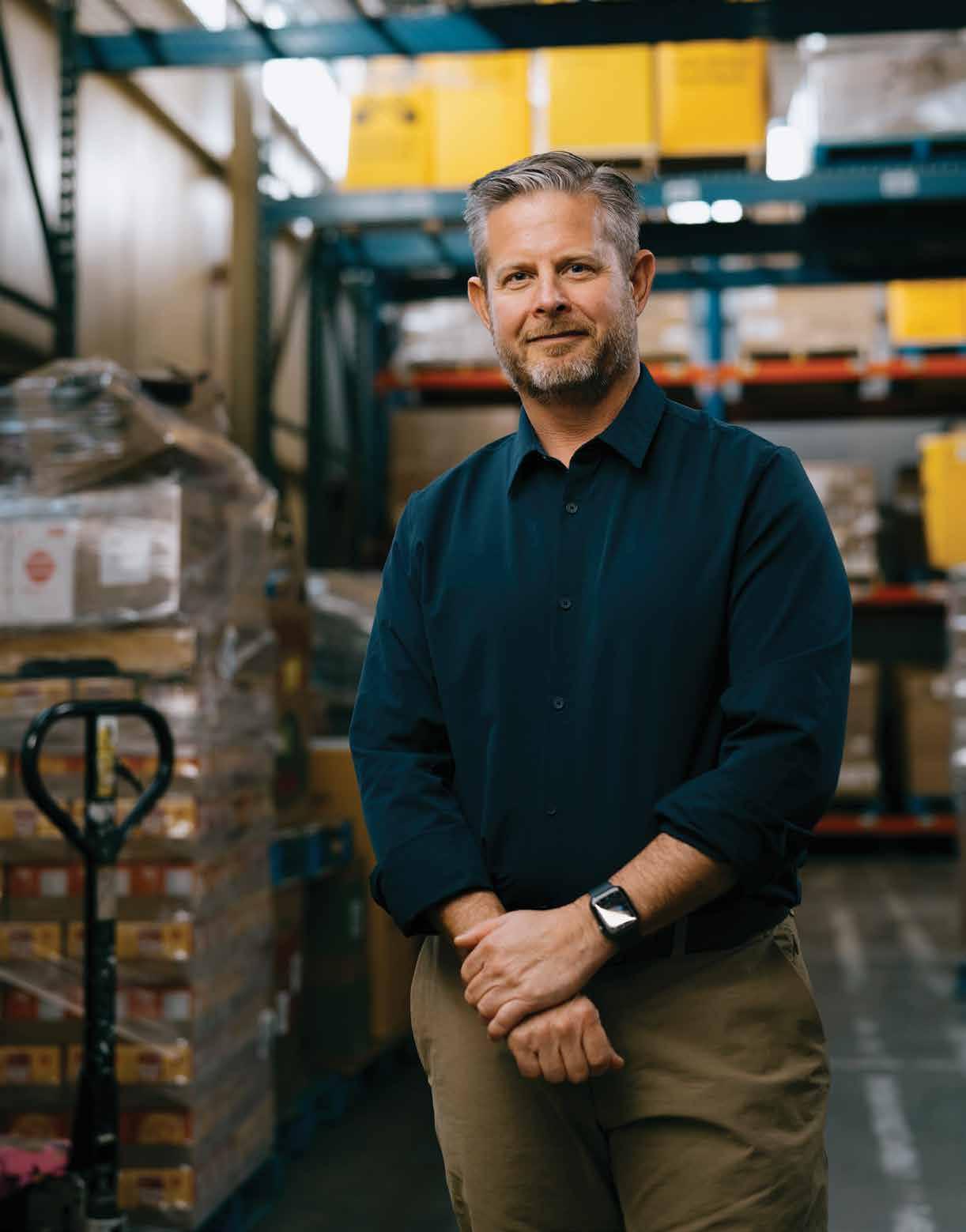
Daily Bread Foodbank’s CEO Neil Hetherington credits a strong, strategic board for the charity’s success. No one has been turned away from a food bank in Toronto, despite the extreme demand, he says.
PHOTO: JOEL RODRIGUEZ
Housing the homeless
Charities
streamline and innovate to address increasing community needs
In response to the bigger issues it handles, United Way Maritimes has streamlined operations and combined fundraising partnerships, says CEO Sara Napier.
IN LOWER SACKVILLE, N.S., November, on the site of a former homeless encampment, residents started moving into their new low-in come tiny homes community, owned and operated by United Way Maritimes. It was a landmark foray into afford able housing by the regional charity, which has capped rent for these fully


for its workplace fund-raising campaigns and distribution of those proceeds to local charitable programs, United Way Maritimes is taking a more proactive stance to address some of the needs that are not being met.
The regional body was formed last year through the voluntary amalgamation of seven United Way organizations in central and southwestern New Brunswick, Prince Edward Island and mainland Nova Scotia. This frees up time and energy to be more innovative, Napier says, who spoke about the unification at
a recent webinar hosted by the Institute of Corporate Directors Maritime Chapter.
The seven predecessor organizations, between them, had 85 board members, with each of those boards having its own charitable number, its own audit, its own governance model and its own requirements for reporting to United Way Centraide Canada, says Napier. The new unified board has seats for between 12 and 17 members.
“We are sharing knowledge, scaling great ideas and programs, combining strategy and fundraising partnerships,
needs increase, donors become more cautious. “It’s the nature of the space that the sector is operating in right now.”
And times could get tougher, depending on the impact United States President Donald Trump’s trade policies have on the Canadian economy. However, MacDonald adds, there is no evidence that Canadian corporations are backing away from their corporate social responsibility commitments, in spite of the anti-ESG backlash in the United States.
Corporate standards
“To be in this space and be operating effectively, organizations need to do everything they can to demonstrate the highest levels of good governance so, as companies, foundations, individuals are looking around for who they might support, they want
and streamlining operations. These changes maximize staff time and talent so we can spend more time proactively building relationships and creating new opportunities in our communities,” Napier says.
Because of the increasing scope and complexity of the issues being addressed by charities and not-for-profits that receive United Way funding, the organization is rolling out its capacity-building programs for the sector throughout the region.
Prince Edward Island’s Executive Director Academy offers classroom education, mentorship and peer leadership on how to be successful in a non-profit organization, Napier says. “We also have a Public Policy Training Institute where anyone working in the non-profit sector can come in with a policy statement or thesis they are working on. We work with deputy ministers and retired elected officials who have a lot of government experience about how we take that idea into a full action plan to impact policy in a really effective way.”
United Way Maritimes is open to greater collaboration with governments, private sector leaders and philanthropists, and aims to be a partner of choice, says Napier, “because our sweet spot is bringing together business, government [and] community to tackle complex issues.” V.G.
de bénévoles et de membres du personnel. Un bon nombre de bénévoles sont des clients de la banque alimentaire qui font ce qu’ils peuvent pour redonner, explique M. Hetherington qui en plus de diriger Daily Bread avec une efficacité digne de Six Sigma (et de manier à l’occasion le chariot élévateur) est un défenseur passionné d’un filet de sécurité sociale plus solide.
Lors d’un événement tenu à la fin de l’année dernière pour annoncer l’adhésion de l’Ontario au programme national universel d’alimentation scolaire du gouvernement fédéral, M. Hetherington a profité de l’occasion pour sensibiliser le premier ministre sortant Justin Trudeau à l’urgence d’accroître les prestations fédérales d’invalidité.
Quand le chef de l’Opposition Pierre Poilièvre a visité l’immense entrepôt de Daily Bread, M. Hetherington lui en a fait faire le tour. Des boîtes de nourriture prêtes à être livrées étaient empilées sur les chevrons. La chambre froide débordait d’oignons, de tomates, de pommes de terre, de carottes,
United Way Maritimes caps rent at 30 per cent of residents’ income at its tiny homes community in Lower Sackville, the site of a former homeless encampment.
‘We are worried that, without some systemic change from the public policy side, we are going to struggle to meet the demand of the city.’
« Nous craignons donc que sans un changement systémique des politiques publiques, nous aurons du mal à répondre à la demande dans la ville. »
Gaylen Duncan, chair, Daily Bread Foodbank
to feel confident they can trust that the dollars they are contributing are delivering impact,” MacDonald says. Charity and NFP directors can also leverage their networks and open doors to a broader base of donors who might support their causes.
The sector has a lot to offer in the way of innovative collaboration with policy makers, says McCain. Premier Andrew Furey of Newfoundland and Labrador, who participated in the Maple Leaf Centre for Food Security’s annual symposium last fall, has partnered with the centre on a $1.8-million food prescription pilot project. Food security is a key social determinant of health and well-being, Furey’s government said when it launched the project, which gives eligible families vouchers to buy nutritious food.
The concept “has expanded tremendously in the United States, which has a whole food-as-medicine movement, produce prescriptions being a part of it,” says the Maple Leaf Centre’s executive director Sarah Stern. “You have got many of the private health insurers, and Medicare and Medicaid now paying for food for people. We’re working quite hard at how we can bring some of those programs at scale into Canada. In the U.S. there are a lot of tax supports so we are trying to figure out how to unlock that here.”
Systemic solutions
In Atlantic Canada, United Way Maritimes has tackled another key determinant of health and well-being in collaboration with the Nova Scotia government and private sector partners: low-income housing. With financial backing from its partners, United Way Maritimes is the owner-operator of a new tiny homes community in Lower Sackville, Nova Scotia. It’s another way of addressing the food insecurity crisis, says CEO Sara Napier. Residents are left with enough disposable income to buy food.
de pommes et d’autres produits offerts par des agriculteurs qui profitent du crédit d’impôt de l’Ontario pour dons à un programme alimentaire communautaire. Il y avait aussi des cartons de lait donnés par des producteurs laitiers ainsi que du pain et des œufs.
L’organisation recourt à l’intelligence artificielle pour prévoir le nombre de personnes qui fréquenteront chaque banque alimentaire ou cuisine communautaire dans la ville au cours des semaines qui viennent, explique Neil Hetherington. « Nous examinons les aliments que nous avons en inventaire et effectuons des achats susceptibles de maximiser la valeur nutritionnelle au plus bas prix. » Chaque client reçoit chaque semaine de la nourriture pour un peu moins de trois jours, dans tous les groupes alimentaires. (Les banques alimentaires ont fait beaucoup de chemin depuis l’époque où les gens devaient faire la queue pendant deux heures « pour se faire servir des restes de Twinkies », observe M. McCain.)
Il s’agit toutefois d’une mesure palliative, pas d’une solution. Beaucoup de ces clients passent une journée sans manger entre les visites parce que leurs coûts de logement sont top élevés. M. Poilièvre a « paru ouvert à l’idée » d’un crédit d’impôt fédéral pour soutenir le don de produits à l’échelle du pays, même si cette mesure seule ne réduirait pas les files de gens à la porte des banques alimentaires, l’a prévenu M. Hetherington.
L’attention accrue accordée à la promotion est un développement bienvenu, assure Bruce MacDonald, chef de la direction d’Imagine Canada, une organisation nationale qui soutient les organismes de bienfaisance et organisations à but non lucratif. « Le fait que la demande d’un changement systémique fasse partie de la conversation est prometteur à long terme », dit-il.
Les associations caritatives et les OBNL jouent un rôle crucial dans la société canadienne, affirme M. MacDonald. Mais lorsque l’économie est mal en point et que les besoins augmentent, les donateurs deviennent plus prudents. « C’est la nature de l’espace dans lequel notre secteur évolue présentement. »
Et les prochains mois pourraient être encore plus difficiles, selon l’impact des politiques commerciales du président américain élu Donald Trump sur l’économie canadienne. Cependant, rien n’indique encore que les entreprises canadiennes renonceront à leurs engagements en matière de responsabilité sociale, malgré l’hostilité envers les mesures ESG aux États-Unis.
Des normes d’entreprise
« Pour habiter cet espace et y travailler efficacement, les organisations doivent faire tout leur possible pour atteindre les niveaux les plus élevés de bonne gouvernance. Car les entreprises, les fondations et les personnes se demandent qui elles devraient appuyer. Elles veulent s’assurer que les dollars qu’elles consentent ont un impact », souligne M. MacDonald. Les administrateurs d’associations caritatives et d’OBNL peuvent aussi mettre à profit leurs réseaux et ouvrir leurs portes à une base plus large de donateurs susceptibles de soutenir leurs causes.
Le secteur a beaucoup à offrir en matière de collaboration innovante avec les décideurs politiques, assure M. McCain. Le premier ministre de Terre-Neuve et Labrador Andrew Furey, qui a participé l’automne dernier au symposium annuel du Centre de Maple Leaf pour la sécurité alimentaire, s’est associé au Centre pour un projet pilote de prescription alimentaire d’une valeur de 1,8 millions de dollars. La sécurité alimentaire est un déterminant social de première importance pour la santé et le bien-être,
‘When you start citing statistics that right here in our own backyard 22 per cent of Canadians are food insecure, it’s jaw-dropping.’
« Quand on commence à citer des statistiques selon lesquelles, dans notre propre cour, 22 pour cent des Canadiens souffrent d’insécurité alimentaire, c’est proprement stupéfiant. »
Michael
McCain, honourary chair, Maple Leaf Centre for Food Security
Duncan says Daily Bread Food Bank is willing to work with any level of government “to help form better policy decisions that address some of the systemic issues that are causing people to go to food banks.”
More and more of the food bank’s clients are people who have post-secondary educations, people who have jobs, “but they still can’t afford living in the city and rely on food banks to supplement some of their food needs.
“We’re the last resort for people,” says Duncan.
Hetherington says a strong, strategic, forward-looking board has kept the organization on track. No one has been turned away from a food bank in Toronto, despite the extreme increase in demand. Directors had the foresight to set aside surplus funds that poured in during the pandemic as a buffer against the post-pandemic inflation we are seeing now.
“The biggest piece the board is struggling with now is how do we continue to meet this increasing demand,” says Duncan. “We do have a depleting reserve that we are working through and that helps us for a short period of time, projected for maybe eighteen months,” Duncan told Director Journal at the end of 2024. “So we are worried that, without some systemic change from the public policy side, we are going to struggle to meet the demand of the city in some time period. It’s just figuring out what that time period exactly is, based on a number of factors.”
The board’s other big concern is staff burnout. Daily Bread is operating full-tilt, seven days a week.
Duncan likens the situation to a frantic hamster race. “You are spinning a wheel where there are more and more clients who need food, we go raise more money, we send out more food. There is this perpetual non-stop focus on getting more, doing more.”
a souligné le gouvernement de M. Furey lorsqu’il a lancé le projet, qui distribue aux familles admissibles des coupons pour acheter des aliments nutritifs. Le concept « s’est développé considérablement aux États-Unis, où il existe tout un mouvement d’alimentation en tant que médicament et les prescriptions de produits en font partie », explique la directrice générale du Centre de Maple Leaf Sarah Stern. « Beaucoup d’assureurs privés dans le domaine de la santé ainsi que les programmes Medicare et Medicaid payent maintenant pour l’alimentation des gens. Nous travaillons très fort à la manière dont nous pourrions instaurer certains de ces programmes à l’échelle du Canada. Aux États-Unis, il existe beaucoup d’aides fiscales dans ce domaine et nous tentons donc d’imaginer comment adopter ce genre d’initiatives. »
Des solutions systémiques
Dans les provinces de l’Atlantique, Centraide Maritimes s’est attaqué à un autre déterminant clé de la santé et du bien-être en collaboration avec le gouvernement de la Nouvelle-Écosse et des partenaires du secteur privé: le logement social. Grâce à l’appui financier de ses partenaires, Centraide Maritimes est propriétaire exploitant d’une nouvelle communauté de minimaisons à Lower Sackville. Voilà une autre façon de faire face à la crise d’insécurité alimentaire, assure la cheffe de la direction Sara Napier. Les résidents disposent maintenant de suffisamment de revenus pour acheter de la nourriture.
M. Duncan affirme que Daily Bread Food Bank est disposée à collaborer avec n’importe quel niveau de gouvernement « pour aider à formuler de meilleures décisions de politique qui s’attaquent à certains des enjeux systémiques qui forcent les gens à recourir aux banques alimentaires. »
De plus en plus de clients des banques alimentaires sont des gens qui ont une formation post-secondaire et occupent des emplois, « mais ils n’ont pas les moyens de vivre en ville et s’en remettent aux banques alimentaires pour combler certains de leurs besoins alimentaires. »
« Pour ces personnes, nous sommes le dernier recours », ajoute M. Duncan. M. Hetherington soutient qu’un conseil solide, stratégique et visionnaire a maintenu l’organisation dans la bonne voie. Personne n’a été refoulé à une banque alimentaire de Toronto, malgré l’extrême croissance de la demande. Les administrateurs ont eu la prévoyance de réserver les fonds supplémentaires qui ont été abondants durant la pandémie comme coussin en prévision de l’inflation postpandémique que nous connaissons maintenant.
« Le plus grand défi du conseil à l’heure actuelle consiste à trouver une façon de continuer à répondre à cette demande croissante, explique M. Duncan. Notre réserve s’épuise et nous aidera pendant encore un certain laps de temps, peut-être dix-huit mois », a-t-il déclaré au Director Journal à la fin de 2024. « Nous craignons donc que sans un changement systémique des politiques publiques, nous aurons du mal à répondre à la demande dans la ville d’ici quelque temps. Il s’agit seulement de déterminer à quel moment exactement cela se produira, en fonction d’un certain nombre de facteurs. »
L’autre grande inquiétude du conseil est l’épuisement du personnel. Daily Bread mène ses activités à toute allure, sept jours sur sept.
M. Duncan compare la situation à une course effrénée de hamsters. « On fait tourner une roue où il y a de plus en plus de clients qui ont besoin de nourriture. Nous recueillons des fonds, nous livrons plus d’aliments. C’est un mouvement perpétuel où il s’agit constamment d’en obtenir plus pour en faire plus. »
Loger les sans-abri
Les organismes caritatifs rationalisent et innovent afin de répondre à des besoins croissants dans la communauté
ÀLOWER SACKVILLE en NouvelleÉcosse, sur le site d’un ancien campement de sans-abri, des résidents à faible revenu ont commencé en novembre dernier à emménager dans leur nouvelle communauté de minimaisons détenues et gérées par Centraide Maritimes.
Ce fut une incursion phare dans le domaine du logement à prix modique par l’organisation caritative, qui a plafonné le loyer de ces unités d’habitation entièrement meublées à 30 pour cent du revenu (services publics compris). Les 70 occupants ont été choisis parmi une liste d’itinérants.
Le projet représente un modèle de l’impact social qu’on peut livrer lorsque les gouvernements, les organismes de bienfaisance et le secteur privé collaborent afin de s’attaquer aux enjeux concomitants de l’itinérance, de la pauvreté et de l’insécurité alimentaire, explique Sara Napier, cheffe de la direction de Centraide Maritimes. Le terrain a été cédé par la Municipalité régionale d’Halifax, des sociétés contractantes privées en ont assuré le développement et construit
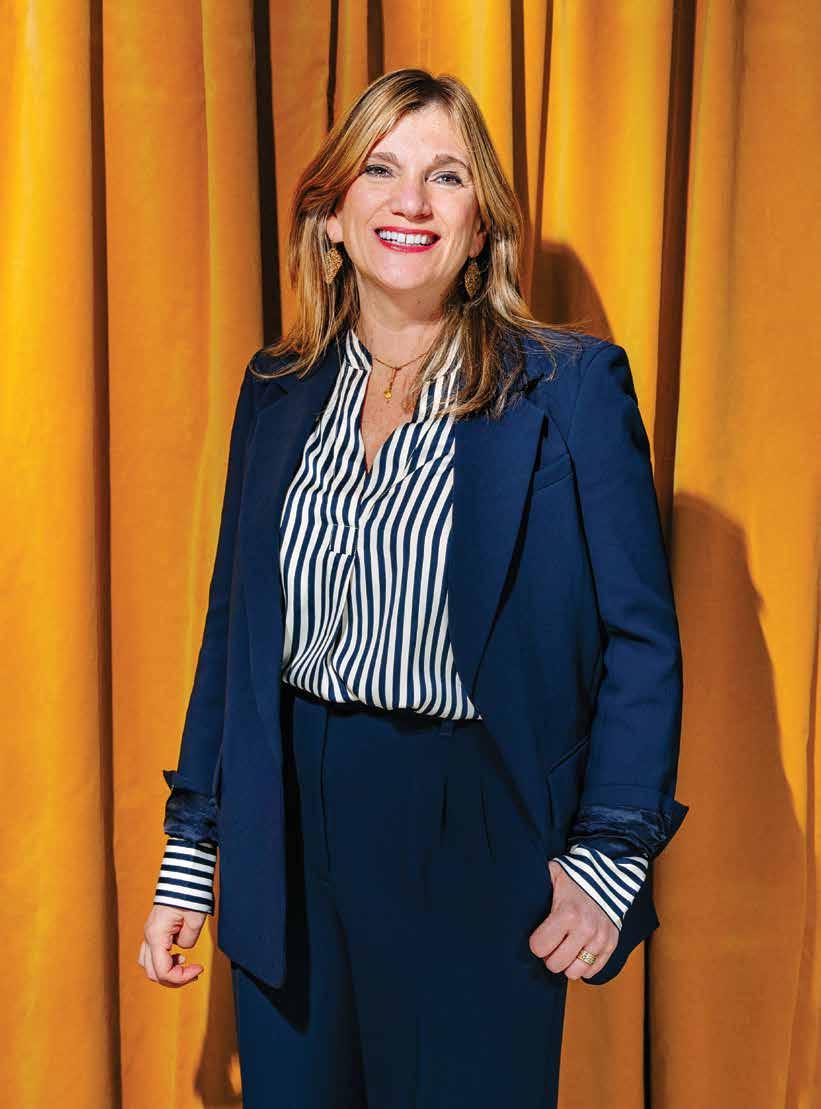

les maisons, le gouvernement de NouvelleÉcosse a assumé les coûts de construction et Centraide est aujourd’hui responsable de la gestion de la propriété.
Même si l’agence est principalement connue pour ses campagnes de financement sur les lieux de travail et la distribution des recettes à des programmes caritatifs locaux, Centraide Maritimes a adopté une approche plus proactive afin de répondre à certains besoins persistants.
L’organisme régional a été formé l’an dernier par l’amalgamation volontaire de sept organisations Centraide du centre et du sud-ouest du Nouveau-Brunswick, de l’Îledu-Prince-Édouard et de la Nouvelle-Écosse continentale. Cette initiative libère du temps et de l’énergie pour davantage d’innovation, souligne Mme Napier qui a évoqué cette unification dans le cadre d’un récent webinaire organisé par la section régionale des Maritimes de l’Institut des administrateurs de sociétés.
Les sept organismes précédents comptaient ensemble 85 administrateurs, chacun de leurs conseils ayant son propre numéro d’organisme de bienfaisance, son propre système d’audit, son propre modèle de gouvernance et ses propres conditions de déclaration à Centraide Canada, affirme Mme Napier. Le nouveau conseil unifié peut accueillir entre 12 et 17 administrateurs.
« Nous partageons des connaissances, mettons à l’échelle des idées et des programmes, combinons les stratégies et partenariats de financement et rationalisons nos opérations. Ces changements permettent d’optimiser le
temps et le talent du personnel de manière à ce que nous puissions consacrer plus de temps à bâtir des relations et à créer des opportunités de façon plus proactive au sein de nos communautés » confie Mme Napier.
En raison de l’ampleur et de la complexité croissantes des enjeux auxquels s’attaquent les organisations caritatives et les organismes à but non lucratif qui reçoivent du financement de Centraide, l’organisation déploie ses programmes de renforcement de ses capacités pour le secteur dans toutes les régions.
L’Executive Director Academy de l’Île-duPrince-Édouard offre de la formation en classe, du mentorat et du leadership par les pairs sur la manière de réussir au sein d’une organisation à but non lucratif, explique Sara Napier. « Nous avons également un Institut de formation en politiques publiques où quiconque travaillant dans le secteur à but non lucratif peut se présenter avec une déclaration de politique ou une thèse en cours de préparation. Nous travaillons avec des sous-ministres et d’anciens élus à la retraite qui ont beaucoup d’expérience du gouvernement sur la façon de concrétiser pleinement des idées en action afin d’imprimer un impact à des politiques de façon vraiment efficace. »
Centraide Maritimes est ouverte à une collaboration accrue avec les gouvernements, les leaders du secteur privé et les personnes engagées dans la philanthropie et entend à cet égard être un partenaire de choix, conclut Mme Napier, « parce que notre force consiste à réunir les gens d’affaires, les gouvernements et la communauté pour s’attaquer à des enjeux complexes. » V.G.

Finding the courage to speak
In a polarized world where anger is instantly amplified through social media platforms, boards need to have candid conversations about where their organizations stand
Morgan Hamel has faced her share of moral dilemmas. Eight years ago, the business ethicist asked her employer to publicly support a social issue she believed was a “no-brainer.” To her surprise, the company refused, saying it was too political. The experience shook Hamel and made her question how well the organization aligned with her own values. Six months later, she and the corporation parted ways.
Hamel then started an ethical fashion business that was true to her values one that embraced sustainability. The Instagram-based company was a hit, generating over a million dollars in responsible garment sales in its first year. But after George Floyd’s murder in 2020, everything changed. A small but vocal minority of community members pressed Hamel to take action she worried would compromise the organization’s ability to succeed.
Ironically, it was a similar issue Hamel had pressed her former company to take a stand on. Only now, in the CEO seat, she was the one feeling the heat. Things got ugly and Hamel ended up closing her business.
“When I share my story, people often blame the critics,” says Hamel. “But this shifts responsibility to others, when, really, it came down to a lack of governance structures and personal
Written by PRASANTHI VASANTHAKUMAR
Illustrations by DAVE MURRAY
Trouver le courage de parler
Dans un monde polarisé où la colère est aussitôt amplifiée par les media sociaux, les conseils doivent mener des conversations franches sur les valeurs de leurs organisations
Morgan Hamel a connu sa juste part de dilemmes moraux. Il y a huit ans, cette éthicienne des affaires a demandé à son employeur de soutenir publiquement un enjeu social qui lui paraissait aller de soi. À sa grande surprise, l’entreprise a refusé, affirmant que l’affaire était trop politique. L’expérience l’a bouleversée et poussée à se demander à quel point l’organisation était cohérente avec ses propres valeurs. Six mois plus tard, elle se séparait de l’entreprise.
Mme Hamel a alors créé sa propre entreprise de mode éthique fidèle à ses valeurs, qui embrassait la notion de développement durable. La compagnie hébergée sur Instagram fut un succès instantané, générant plus d’un million de dollars de ventes de vêtements responsables dès sa première année. Mais après le meurtre de George Floyd en 2020, tout a changé. Une minorité, réduite mais tonitruante, de membres de la communauté l’ont pressée de prendre des mesures dont elle craignait qu’elles compromettent la capacité de réussite de son organisation.
preparedness. There’s a lot of anger and people are looking for an outlet. As we’ve seen with the [UnitedHealthcare] CEO murder in the U.S., these types of things are coming, unfortunately, fast and furious. I’ve literally studied business ethics for my entire career, but social media has changed the game, and I was not equipped.”
From pocketbook problems and social inequality to perceived failures by governments, corporations and institutions, many people have a lot to be angry about. It’s why societal polarization has catapulted into third place above cybersecurity and interstate armed conflict on the World Economic Forum’s 2024 list of short-term risks. It’s also why Darren Walker believes we are stuck in a culture of absolutism and extremism. In a speech last year, the then-president of the Ford Foundation an American organization with a commitment to social justice called for moral and courageous leadership that embraces nuance and complexity.
“Everything right now, it seems, is black or white, all or nothing, perfect or unacceptable,” Walker said in a lecture series in New York City.
‘No time to think’
Many boards do not have societal polarization on their radar, says Hamel, who, as president of MH Partners Inc., helps corporate leaders navigate stakeholder expectations.
She observes that “likes” and “shares” took off on social media in 2012, but the power of these two buttons to amplify content wasn’t evident until the #MeToo movement five years later. Companies that could rely on PR agencies to quietly manage crises have now been pressed to publicly speak up on a slew of issues. Their response, or lack thereof, can garner wide attention online.
It’s what happened to Hamel when she was pressured to take action at her fashion company. “Because of social media, there was no time to think,” she says. “I needed to have a response that day, and in the absence of a response, people made up what that meant about my commitment to that cause.”
In her work now, Hamel observes that many directors are not as active on social media as the organizations they govern, which can create a “blind spot” to these risks. To complicate matters, the environment is rapidly shifting. In 2020, many organizations posted a black square on social media to show their commitment to anti-racism. Now, however, with the election of U.S. President Donald Trump and heightening “anti-woke” rhetoric, the pendulum has swung the other way, she says. Boards need to understand these risks and realize they will be asked to take a public position on a smorgasbord of issues.
The power of silence
Sometimes, not taking a position can be an act of courage. For public companies, any decision to take a position must be
Ironiquement, c’est un enjeu semblable que Mme Hamel avait soulevé auprès de son ancienne entreprise en sollicitant sa prise de position. Sauf que maintenant qu’elle occupait le siège de cheffe de la direction, c’est elle qui sentait la chaleur. Les choses sont allées de mal en pis et elle a fini par fermer son entreprise.
« Quand je partage mon histoire, les gens blâment souvent les critiques, dit-elle. Mais ainsi, ils en font porter la responsabilité à d’autres alors qu’en fait, cela se résume à un manque de structures de gouvernance et de préparation personnelle. Il y a beaucoup de colère et les gens recherchent une soupape. Comme je l’ai constaté avec le meurtre du chef de la direction [d’United Healthcare], ce genre de choses, malheureusement, se produit sur le coup de l’émotion. J’ai littéralement étudié l’éthique des affaires pendant toute ma carrière, mais les media sociaux ont changé la donne et je n’étais pas équipée pour faire face à la situation. »
Qu’il s’agisse de problèmes qui affectent leur portefeuille, d’inégalités sociales ou d’échecs attribués aux gouvernements, aux sociétés et aux institutions, bien des gens sont habités par la colère. Voilà pourquoi la polarisation sociétale a été catapultée en troisième place après la sécurité informatique et les conflits armés entre États de la liste des risques à court terme dressée par le Forum économique mondial. C’est aussi pourquoi Derek Walker croit que nous sommes coincés dans une culture d’absolutisme et d’extrémisme. Dans une allocution prononcée l’an dernier, celui qui était alors président de la Fondation Ford une organisation américaine prônant la justice sociale a appelé à un leadership moral et courageux qui embrasse la nuance et la complexité.
« Il semble qu’aujourd’hui, tout soit noir ou blanc, parfait ou inacceptable », a-t-il déclaré dans le cadre d’une série de conférences à New York.
« Pas de temps pour réfléchir »
Beaucoup de conseils n’ont pas la polarisation sociale sur leur radar, soutient Mme Hamel qui, à titre de présidente de MH Partners Inc., aide les chefs d’entreprise à répondre aux attentes des parties prenantes.
Elle observe que les ‘j’aime’ et les ‘partager’ ont pris leur essor sur les media sociaux en 2012, mais que le pouvoir de ces deux boutons pour amplifier la satisfaction n’a pas été évident jusqu’à l’apparition du mouvement #MeToo cinq ans plus tard. Les entreprises qui pouvaient s’en remettre à des agences de relations publiques pour gérer calmement des crises sont maintenant sollicitées pour s’exprimer publiquement sur une pléthore d’enjeux. Leur réponse ou leur absence de réponse peut susciter beaucoup d’attention en ligne.
C’est ce qui est arrivé à Morgan Hamel quand elle a été pressée d’intervenir à son entreprise de mode. « À cause des media sociaux, je n’avais pas le temps de réfléchir, dit-elle. Il me fallait donner une réponse le jour même et en l’absence de réponse, les gens ont tiré leurs propres conclusions quant à mon engagement envers cette cause. »
Dans son travail actuel, Mme Hamel observe que beaucoup d’administrateurs ne sont pas aussi actifs sur les media sociaux que les organisations qu’ils gouvernent, ce qui peut créer un « angle mort » à l’égard de ces risques. Pour compliquer les choses, l’environnement change rapidement. En 2020, plusieurs organisations ont affiché un carré noir sur les media sociaux pour témoigner de leur engagement antiraciste, mais aujourd’hui, avec l’élection de Donald Trump et le renforcement de la rhétorique « antiwoke », le pendule a balancé dans l’autre sens.

guided by a goal of creating long-term shareholder value, says Calgary-based corporate director Art Korpach. Is a company taking a stand because it wants to elicit a stakeholder response that creates shareholder value in the future? If not, there is no business purpose to enter the fray.
Courageous leadership means withstanding short-term pressures for long-term gains. It also means not jumping on the “narrative-du-jour bandwagon,” because the crowd is often wrong, he says. “It actually takes more courage not to go along with the crowd.”
In Korpach’s view, public companies should be neutral. Because when organizations take a position on one issue, they’ll be expected to do so on others. After all, directors act as stewards for other people’s money, not for their own social causes, he says.
“Unless there’s a very direct tie back to an objective and a future net benefit to the company, you want to keep your head down,” he says. “And that doesn’t mean you’re not courageous. Take the flak that exists right there, as opposed to acting to avoid it and exposing the organization to potentially greater risk in the future. There are many organizations that, in hindsight, wish they had remained neutral.”
Play host, not hero
At the University of Western Ontario’s Ivey Business School in London, Ont., stakeholder versus shareholder primacy is a common topic of discussion in the classroom. But business
Les conseils doivent comprendre ces risques et réaliser qu’on leur demandera de prendre position publiquement sur toute une panoplie de questions.
Le pouvoir du silence
Parfois, le fait de ne pas prendre position peut être un acte de courage. Pour les entreprises inscrites en bourse, toute décision de prendre position doit être guidée par un objectif de créer de la valeur à long terme pour les actionnaires, croit l’administrateur de sociétés Art Korpach de Calgary. Est-ce qu’une société prend position parce qu’elle souhaite susciter une réponse des parties prenantes qui créera de la valeur pour les actionnaires dans l’avenir? Si ce n’est pas le cas, il n’y a aucun avantage commercial à entrer dans la mêlée.
Un leadership courageux consiste à résister aux pressions à court terme en échange de gains à long terme. Il consiste aussi à ne pas sauter dans le wagon de la popularité immédiate « parce que le public a souvent tort, dit-il. En fait, il faut plus de courage pour aller à contre-courant de l’opinion publique. »
Selon M. Korpach, les entreprises inscrites en bourse devraient être neutres. Parce que lorsque des organisations prennent position sur une question, on s’attend à ce qu’elles le fassent sur d’autres enjeux. Après tout, les administrateurs agissent comme gardiens de l’argent des autres, non de leurs propres causes sociales, soutient-il.
« À moins qu’il y ait un lien très direct avec un objectif et un avantage futur net pour l’entreprise, on veut rester discret, dit-il. Et ça ne veut pas dire qu’on manque de courage. Il s’agit d’accepter la critique plutôt que d’agir de manière à l’éviter et ainsi exposer l’organisation à des risques plus graves à l’avenir. Il y a beaucoup d’organisations qui, dans leur for intérieur, regrettent de ne pas être demeuré neutres. »
Jouez les hôtes, pas les héros
À l’Ivey Business School de l’Université Western Ontario à London, l’opposition quant à la primauté des parties prenantes ou des actionnaires est un thème commun de discussion en classe. Mais le professeur de commerce Gerard Seijts ne croit pas que les deux approches soient diamétralement opposées. C’est pourquoi Michael McCain, ancien chef de la direction de Les Aliments Maple Leaf, Charles Brindamour, chef de la direction d’Intact Corporation financière et l’administratrice Barbara Stymiest viennent à l’esprit quand on évoque des leaders courageux. Les trois se sont exprimés sur des enjeux en rapport avec l’amélioration des affaires et de la société, souligne M. Seijts.
« On a besoin de plus de leaders courageux qui nous disent ce que nous avons vraiment besoin d’entendre plutôt que ce que nous voulons entendre, poursuit Gerard Seijts. On a besoin de leaders qui comprennent que le leadership n’est pas un concours de popularité, mais qu’il y a certaines choses dans la société qu’il faut commencer à réaliser. Mais les articuler, se pencher sur ces questions est incroyablement difficile. »
Selon M. Seijts, ce défi sera relevé par des leaders ouverts d’esprit. En raison de la complexité des enjeux actuels, les leaders doivent s’exprimer avec humilité, empathie et compassion. Ils peuvent s’engager dans
‘There are many organizations that, in hindsight, wish they had remained neutral .’
‹ Il y a beaucoup d’organisations qui, dans leur for intérieur, regrettent de ne pas être demeuré neutres. ›
Art Korpach, Corporate director
des débats vigoureux, mais exprimer leurs désaccords avec respect. Et ils doivent faire preuve de retenue. Même si l’émotion pure peut être une bonne chose, trop d’émotion peut faire dérailler une conversation. Il est aussi important de faire preuve de prudence. « Vos mots sont comme de la pâte dentifrice, affirme M. Seijts. Une fois sortis, vous ne pouvez pas les remettre dans le tube. Les gens vous en tiennent responsable et l’affaire relève, dès lors, du domaine public. »
Ultimement, les leaders doivent agir comme des hôtes, non comme des héros qui ont toutes les réponses. En tant qu’hôtes, ils réunissent les meilleurs et les plus brillants et facilitent des conversations qui mènent à des résultats intelligents.
professor Gerard Seijts doesn’t think the two approaches are diametrically opposed. It’s why Michael McCain, former CEO of Maple Leaf Foods, Charles Brindamour, CEO of Intact Financial Corp., and corporate director Barbara Stymiest come to mind when he thinks of courageous leaders. All three have spoken out on issues for the betterment of business and society, says Seijts.
“We need more courageous leaders who tell us what we really need to hear as opposed to what we want to hear,” Seijts says. “We need leaders who understand that leadership is not a popularity contest, but there’s certain things in society that we need to start to realize. But to articulate, to lean in, is incredibly challenging.”
For Seijts, this challenge calls for leaders with an open mind. Because of today’s complex issues, leaders must speak up with humility, empathy and compassion. They can engage in vigorous debate, but disagree with respect. And they must show self-restraint: While raw emotion can be a good thing, too much emotion can derail the conversation.
It’s also important not to be reckless. “Your words are like toothpaste,” Seijts says. “Once it’s out, you can never push it back. People hold you accountable and it’s now a matter of public record.”
Ultimately, leaders need to act as hosts, not heroes with all the right answers. As hosts, they bring together the best and brightest, and facilitate conversations that lead to smart outcomes.
“As a leader, you don’t have to be right at the start of the conversation,” Seijts says. “I want you to be right at the end of the conversation.”
Mind the gap
No matter where boards fall on the stakeholder-shareholder spectrum, open conversation is a must. But freely sharing one’s views on contentious topics is easier said than done.
Moral polarization is partly to blame, says Hamel. It refers to the growing divergence of moral beliefs within a group that can create a perceived moral gap between individuals. People tend to view those with a different opinion as not only wrong, but bad or evil, which can make it feel risky to speak up.
Hamel has also spoken to board members who feel they
« En tant que leader, on n’a pas à avoir raison au début de la conversation, explique M. Seijts. On veut avoir raison à la fin. »
Attention aux fossés moraux
Peu importe la position des conseils dans le spectre parties prenantesactionnaires, il est essential d’avoir une conversation ouverte. Mais de partager librement ses points de vue sur des sujets contentieux est plus facile à dire qu’à faire.
La polarisation morale est en partie responsable de cette situation, croit Mme Hamel. Elle s’applique à la divergence croissante entre les croyances morales au sein d’un groupe, ce qui est susceptible de créer la perception d’un fossé moral entre les personnes. Les gens tendent à voir ceux qui professent une opinion différente de la leur non seulement comme ayant tort, mais comme mauvais ou diaboliques, ce qui peut donner le sentiment qu’il est risqué de s’exprimer.
Mme Hamel a aussi discuté avec des administrateurs qui ont le sentiment de ne pas être autorisés à s’exprimer sur certains enjeux. Un administrateur de race blanche peut penser que son point de vue sur une stratégie à l’égard des enjeux autochtones n’est pas bienvenu, mais il peut avoir une perspective valable sur la question. Elle s’inquiète de ce que cet effet dissuasif sur la liberté d’expression soit mauvais pour les entreprises. « Les parties prenantes sont multiformes et offrent divers points de vue sur ce qu’une entreprise devrait faire et jusqu’à quel point, mais il n’y a pas d’espace pour s’engager dans ce type de conversation au niveau du conseil, là où on établit le ton de la gouvernance. Ainsi, la conversation ne se répercute pas, poursuit-elle. Et le risque est alors grand de subir ces blessures de polarisation qui peuvent être mortelles, comme ce fut mon cas. »
Partager des points de vue divers
En rétrospective, Morgan Hamel aurait voulu avoir accès à des points de vue plus diversifiés lors de la crise survenue à son entreprise de mode. À l’époque, elle avait le sentiment que son avis de consultante en DEI ne tenait pas suffisamment compte de l’aspect commercial de l’enjeu. Sans un point de vue plus orienté vers les affaires pour offrir un équilibre, elle s’est débattue pour répondre à la pression qu’elle subissait. Voilà pourquoi elle dit qu’il est impératif pour les conseils de créer une culture de sécurité psychologique où les gens puissent partager librement des opinions diverses. Pour partager des points de vue divers et accueillir les nuances, les conseils doivent pouvoir compter sur de la diversité de pensée autour de la table, affirme l’administratrice de sociétés Maureen Moneta d’Edmonton. Par exemple, les membres du conseil issus d’autres industries peuvent enrichir une conversation parce qu’ils voient naturellement les choses
do not have a licence to contribute on certain issues. A white director may think their perspective on a strategy around Indigenous issues is unwelcome, but may have valuable insight. She worries this chilling effect on speech is bad for business.
“Stakeholders are multifaceted with different perspectives on what and how much [an organization] should do, but if there isn’t space to engage in these conversations at the board level where we’re setting the governance tone, then it doesn’t filter down,” Hamel says. “And the risk is you get these polarization injuries that can be mortal, like mine.”
Share diverse views
In hindsight, Hamel wishes she had had access to more diverse views during her fashion company’s crisis. At the time, she felt her DEI consultant’s advice did not fully consider the commercial side of the issue. Without a more business-oriented viewpoint to provide balance, Hamel struggled to respond to the pressure she faced. It’s why she says it’s imperative that boards create a culture of psychological safety where people can freely share diverse perspectives.
To share diverse perspectives and embrace nuance, boards need diversity of thought at the table, says Edmonton-based corporate director Maureen Moneta. For example, board members from other industries can enrich a conversation because they naturally view issues differently. However, the board must also create an environment of inclusion.
“It’s one thing to have diverse thinking in the room, but it’s another thing for people to actually share those diverse views,” says Moneta. The chair plays a critical role in creating these optimal conditions. On one of Moneta’s boards, the chair shuffles the order in which members speak, so the same directors are not first or last into a conversation. This reordering can change how the discussion unfolds.
Chairs can also inspire courage by showing vulnerability. “I’ve been on boards where the chair has said, ‘I’m not sure I’m going to get this exactly right, but I’m going to try anyway,’ and I think that’s gone a long way,” Moneta says.
If the board reaches a decision quickly, any director can play devil’s advocate: What’s the counterargument? Do we have the right perspectives in the room to ensure all risks and opportunities are considered? What are we missing? Moneta has seen this approach work well, too.
Find your line
These candid, nuanced conversations are as essential for preparing for polarization risks as any other risk. They also help boards create frameworks that can guide organizations on how and when to take a stand on issues.
For example, the board of a food bank may decide to use clean energy even if one donor threatens to withhold funds over this decision. But if more than half of all donors threaten
d’un autre œil. Toutefois, le conseil doit aussi créer un environnement d’inclusion.
« C’est une chose d’avoir une pensée diversifiée à la table, mais c’en est une autre pour les gens de partager, dans les faits, des points de vue divers, sachant en particulier qu’ils pourraient se retrouver seuls, explique Mme Moneta. Le courage est une qualité que possèdent beaucoup d’administrateurs, mais il faut des conditions propices pour le voir se déployer à la table du conseil. »
La présidence du conseil joue un rôle crucial pour créer des conditions optimales. À l’un des conseils où elle siège, la présidence mêle l’ordre dans lequel les membres s’expriment sur des questions clés. Ainsi, ce ne sont pas toujours les mêmes administrateurs qui sont les premiers ou les derniers à participer à la conversation. Les administrateurs répondent souvent à d’autres commentaires ou élaborent sur ce qui a été dit. Donc, ce réaménagement peut modifier la façon dont la discussion se déroule.
Les présidents du conseil peuvent aussi inspirer le courage en montrant leur vulnérabilité. « J’ai siégé à des conseils où le président disait : ‘Je ne suis pas certain de faire les choses exactement comme il faut, mais je vais quand même essayer’ et je pense que ce fut une très bonne chose », assure Mme Moneta.
Mais tous les membres du conseil doivent faire leur part. Si le conseil en arrive rapidement à une décision, n’importe quel administrateur peut jouer le rôle de l’avocat du diable. Quel est le contre-argument? Avons-nous la bonne perspective à la table pour faire en sorte de bien envisager les risques et les opportunités? Qu’est-ce qui nous échappe? Mme Moneta a vu cette approche donner des résultats.

‘We need more courageous leaders who tell us what we really need to hear, as opposed to what we want to hear.’
‹ On a besoin de plus de leaders courageux qui nous disent ce que nous avons vraiment besoin d’entendre plutôt que ce que nous voulons entendre. ›
— Gerard Seijts, business professor, University of Western Ontario
Tracer la ligne à suivre
Ces conversations franches et nuancées sont aussi essentielles pour faire face aux risques de polarisation qu’à toute autre forme de risque. Elles peuvent aussi aider les conseils à créer des cadres de travail qui peuvent guider les organisations quant à la manière et au moment de prendre positions sur des enjeux.
Par exemple, le conseil d’une banque alimentaire pourrait décider de recourir à de l’énergie propre, même si un donateur menaçait de retenir des fonds à cause de cette décision. Mais si plus de la moitié de tous les donateurs menacent de mettre fin à leurs contribution pour la même raison, cela peut compromettre la capacité de l’organisation de remplir sa mission principale. Cet exemple hypothétique illustre pourquoi les conseils doivent envisager les questions de tous les points de vue.
to stop donating for the same reason, it can compromise the organization’s ability to deliver on its core mission.
“It’s important to think through these topics and get clear on where your line is,” Hamel says. “Otherwise, the risk is you blow with the wind and do DEI when it’s ‘in,’ and then eliminate it completely the next day.”
In addition to a framework governing how and when to take a stand, boards should ensure organizations review internal policies with such risks in mind. Some companies have recently implemented policies and training for respectful political conversations in the workplace to quell animosity among employees. Clear social media policies around free speech and what employees can say online are also important, Hamel says.
Boards must have a risk-identification process to ensure they create the conditions to have productive discussions about polarized topics, she says.
Embrace the grey
While her own values guided much of her decision-making early in her career, Hamel says she’s adopted a broader, more nuanced perspective now one that takes into account the grey areas. In today’s environment, making choices based solely on the concept of “right and wrong” is unhelpful, she says. Instead of being “for or against” issues, directors should view them as “polarities to manage” a concept put forward by U.S. author Barry Johnson rather than problems to solve. With this perspective, directors can consider how to maximize the upside and minimize the downside of issues, while tapping into that tension.
“We all love to think of ourselves as ethical people,” Hamel says. “The idea of black and white, and thinking in binary, right and wrong, feels very safe and clear. But behavioural ethics research shows quite clearly that we aren’t as ethical as we think. So, [we need to] dive into the grey and get curious about the complexity. Where is making the right decision difficult for me, and where does it get hard for us as an organization?”
« Il est important de réfléchir à ces questions et de tracer clairement la ligne à suivre, souligne Mme Hamel. Sinon, on risque d’aller là où le vent souffle, d’embrasser les DEI quand c’est à la mode et de les éliminer complètement le lendemain. Dans des cas semblables, les employés se disent : ‘Mais qu’est-ce qui se passe?’ »
En plus d’un cadre gouvernant la façon et le moment de prendre position, les conseils devraient faire en sorte que les organisations révisent leurs politiques internes en gardant ces risques à l’esprit. Certaines entreprises ont récemment mis en place des politiques et des initiatives de formation en vue de susciter des conversations respectueuses sur les lieux de travail afin de réduire l’animosité parmi les employés. Des politiques claires à l’égard des media sociaux concernant la liberté d’expression et ce que les employés peuvent dire en ligne sont aussi importantes, assure Mme Hamel.
Les conseils doivent avoir un processus d’identification des risques afin de créer les conditions de discussions productives autour de sujets polarisés. Des exercices sur table peuvent aider les administrateurs à se préparer à ce type de poussées polarisantes, dit-elle.
Embrasser le gris
Même si ses propres valeurs ont guidé une bonne partie de ses décisions au début de sa carrière, Morgan Hamel dit qu’elle a adopté une perspective plus large et plus nuancée maintenant, laquelle tient compte des zones grises. Dans l’environnement actuel, faire des choix uniquement en fonction des concepts de « bien ou mal » est inutile, affirme-t-elle. Plutôt que d’être des enjeux « pour ou contre », les administrateurs devraient les considérer comme des « polarités à gérer » un concept mis de l’avant par Barry Johnson, un auteur américain et leader visionnaire plutôt que des problèmes à régler. Avec une telle perspective, les administrateurs peuvent envisager comment optimiser les avantages et minimiser les inconvénients des enjeux, tout en exploitant ces tensions.
« Nous aimons tous nous considérer comme des personnes ayant des valeurs éthiques, explique Mme Hamel. L’idée de blanc et noir, de penser en mode binaire, en bien et mal, paraît sécurisante et claire. Mais les recherches en éthique du comportement montrent très clairement que nous ne sommes pas aussi respectueux de l’éthique que nous voulons bien le croire. Donc, il nous faut plonger dans le gris et devenir curieux de complexité. À quel moment est-il difficile pour moi de prendre la bonne décision et à quel moment cela devient-il difficile pour nous en tant qu’organisation? »

Hold that thought?
Boards may be tempted to delay big decisions in the face of political uncertainty, but too much indecisiveness can hurt a business, Jeff Buckstein writes
Boards working on strategic plans face a key question in anticipation of a pivotal federal election in coming months: Should they delay making big decisions until they have greater clarity after the vote?
The Liberal government is expected to face a no-confidence vote shortly after the next parliamentary session begins on March 24, which would trigger a spring election. Although polls suggest the strong possibility of a new Conservative government led by Pierre Poilievre, which is offering markedly different policies than the Liberals, it is unclear whether the Conservatives will end up with a majority. And with the Liberals set to choose a new leader in the wake of Justin Trudeau’s decision to resign as prime minister, there are a lot of changes afoot.
“This is a huge election for Canada and it’s got a lot of risk attendant with it, depending on who wins, for all companies, given how they make decisions, particularly prior to the federal election,” says Glenn Rowe, a professor of general management and strategy at the University of Western Ontario’s Ivey School of Business in London.
Unknowns include new legislation and the potential repeal of old legislation, as well as the size of U.S. tariffs threatened by the new Trump administration. Boards must decide whether to proceed with major decisions during this period of volatility, or wait until there is more certainty after the election.
Boards defer making decisions at their own peril; they should avoid indecisiveness and getting caught up in the politics, advises Fred Mifflin, vice-chair of Blair Franklin Capital Partners in Toronto. “I don’t think they should be making politically based decisions,” he says. “Boards are in the business of making risk-adjusted decisions all the time, based on where they can earn returns on a risk-adjusted basis.”
“This is all about risk management,” adds Victor Li, executive-vice president of governance advisory at Kingsdale Advisors in Toronto, who notes that whenever a company makes a decision, political risk is always part of the analysis.
WINNER TAKE ALL
Board members who are bold enough to make corporate decisions based on an anticipated outcome of the federal election could end up with the highest rewards if they guess correctly, says the Ivey School’s Rowe.
Remettre à plus tard?
Les conseils pourraient être tentés de retarder des décisions importantes face à l’incertitude politique, mais trop d’indécision peut faire mal à une entreprise, écrit Jeff Buckstein
Les conseils occupés à l’élaboration de plans stratégiques doivent résoudre une question clé en prévision d’une élection fédérale de première importance dans les prochains mois : devraient-ils retarder des décisions majeures jusqu’à ce que les résultats électoraux soient connus?
On s’attend à ce que le gouvernement fédéral doive faire face à un vote de non-confiance peu après le début de la session parlementaire le 24 mars, ce qui déclencherait une élection printanière. Même si les sondages évoquent la forte possibilité d’un nouveau gouvernement conservateur dirigé par Pierre Poilièvre, dont les politiques diffèrent nettement de celles des Libéraux, il n’est pas certain que les Conservateurs remporteront une majorité de sièges. Et dans un contexte où les Libéraux doivent choisir un nouveau chef dans la foulée de la démission de Justin Trudeau comme premier ministre, il y a beaucoup de changement à l’horizon.
« Il s’agit pour le Canada d’une élection majeure qui comporte beaucoup de risques, selon le gagnant, pour toutes les entreprises, compte tenu de la manière dont elles prennent des décisions, en particulier avant le rendez-vous électoral, affirme Glenn Rowe, professeur de gestion générale et de stratégie à l’Ivey School of Business de l’Université Western Ontario.
Parmi les inconnues figurent de nouvelles législations et l’éventuel abrogation de vieilles lois ainsi que l’ampleur des tarifs américains dont la nouvelle administration Trump menace le Canada. Les conseils doivent décider s’ils prendront des décisions importantes durant cette période d’instabilité ou s’ils attendront que les choses se clarifient après l’élection.
Les conseils diffèrent la prise de décision à leurs propres risques; ils devraient éviter l’indécision et ne pas se laisser entraîner dans des questions de politique, recommande Fred Mifflin, vice-président de Blair Franklin Capital Partners de Toronto. « Je ne crois pas qu’ils devraient prendre des décisions basées sur la politique, dit-il. La tâche des conseils consiste à prendre constamment des décisions en fonction des risques, des rendements qu’ils sont susceptibles d’obtenir en tenant compte des risques. »
« Tout cela relève de la gestion du risque », ajoute Victor Li, vice-président exécutif chargé des conseils en gouvernance chez Kingsale Advisors de Toronto, qui souligne que chaque fois qu’une entreprise prend une décision, le risque politique fait partie de l’analyse.
In contrast, directors with a lower tolerance for risk might place more emphasis on the potential disadvantage of making such a prediction, which is guessing wrong, and therefore hold off on major decisions until after the election. While that is a less risky strategy, generally speaking “those who play it safe don’t achieve as much as those who are willing to take a risk and are right,” Rowe says.
Officers and directors must, therefore, ask themselves what their risk tolerance is, and what is best for their corporation.
“We have a group of men and women sitting on a board directing a CEO and officers of a company, all with the fiduciary responsibility to make decisions in the best interests of the corporation,” he says.
Boards need to hold internal discussions so they can understand directors’ priorities. For example, some in the group might speak from the corporation’s perspective, others from the broader stakeholder perspective, and the rest might be looking at issues from a narrower shareholder perspective. This way, “when they’re discussing something, each board member knows what perspective their fellow board member is coming from,” Rowe says.
Even in the face of enormous uncertainty, boards must understand how to steer their organization in the right direction, says Chelsea Willness, a professor of organizational behaviour at the University of Calgary’s Haskayne School of Business.
“Ultimately, boards and the organizations that they are stewarding are composed of human beings. There are certain things we know about how people make decisions, whether it’s individually or in groups, that play out here, like loss aversion [and] risk aversion,” she says.
“It comes down to fiduciary duty at the most fundamental level. You want to have the most accurate and complete information, whether it’s for strategic planning or even just making decisions on what actions the corporation should be taking,” she says.
Board members need to be aware that waiting out an important decision might signal to corporate stakeholders that the leadership lacks confidence. Alternatively, if the board is gathering as much information as possible before an important decision is made, this could signal prudence and responsible decision-making, Willness says.
The board and organization do not want to create the perception that their leadership is indecisive. It is, therefore, important to have a transparent communications strategy in place to ensure they are delivering the right message to stakeholders, she advises.
THE TRUMP THREAT
Boards also face key risks beyond the outcome of Canada’s next federal election, including U.S. President Donald Trump’s proposed 25 per cent tariffs, political turmoil in France and Germany, and financial troubles in the burgeoning electric vehicle industry. Directors need to take all this and more
LE GAGNANT RAFLE LA MISE
Les administrateurs suffisamment audacieux pour prendre des décisions d’entreprise en fonction des résultats anticipés de l’élection fédérale pourraient décrocher le gros lot s’ils ont fait le bon choix, affirme M. Rowe. En revanche, les administrateurs ayant une tolérance moindre au risque pourraient accorder plus d’importance au désavantage possible associé à une telle prédiction, qui pourrait s’avérer fausse, et ainsi reporter la prise de décisions importantes jusqu’après l’élection. Même s’il s’agit d’une décision moins risquée, on peut dire qu’en général « ceux qui ne courent pas de risques ne réussissent pas autant que ceux qui risquent et gagnent », soutient M. Rowe.
Dirigeants et membres du conseil doivent donc se demander quel est leur degré de tolérance au risque et ce qui est préférable pour leur organisation.
« On a un groupe d’hommes et de femmes au conseil qui prodiguent des avis aux membres de la haute direction d’une entreprise et ont tous la responsabilité fiduciaire de prendre des décisions dans les meilleurs intérêts de l’organisation », poursuit-il.
Les conseils doivent tenir des discussions internes de manière à comprendre les priorités des administrateurs. Ainsi, certains membres du groupe peuvent s’exprimer du point de vue de l’entreprise, d’autres du point de vue plus large des parties prenantes et les autres peuvent envisager les enjeux plus étroits des actionnaires. De cette façon, « lorsqu’une discussion a cours au conseil, chaque membre connaît la perspective de ses collègues », explique M. Rowe.
Même dans un contexte de profonde incertitude, les conseils doivent comprendre comment orienter leur organisation dans la bonne direction, souligne Chelsea Willness, professeure de comportement organisationnel à la Haskayne School of Business de l’Université de Calgary.
« Ultimement, les conseils et les organisations dont ils sont responsables sont composés d’êtres humains. Il y a certaines choses que nous savons sur la façon dont les gens prennent des décisions, que ce soit individuellement ou en groupe, qui sont en jeu ici, comme l’aversion pour les pertes et l’aversion pour le risque », dit-elle.
« Cela se résume à la responsabilité fiduciaire à son niveau le plus fondamental, poursuit-elle. On veut disposer de l’information la plus exacte et la plus complète, que ce soit dans le cadre de la planification stratégique ou même simplement pour prendre des décisions sur les initiatives que l’organisation devrait adopter. »
Les membres du conseil doivent être conscients que le fait de différer une décision importante peut indiquer aux parties prenantes que les dirigeants manquent de confiance. Alternativement, si le conseil recueille autant d’information que possible avant qu’une décision importante soit prise, cela pourrait signaler de la prudence et une prise de décision responsable, souligne Mme Willness.
Le conseil et l’organisation ne désirent pas créer la perception que leur leadership est indécis. Il est donc important de mener une stratégie de communications transparente pour s’assurer de livrer le bon message aux parties prenantes, conseille-t-elle.
LA MENACE TRUMP
Les conseils font aussi face à des risques qui vont au-delà de la prochaine élection fédérale, dont celui que posent les tarifs de 25 pour cent proposés par le président Donald Trump, l’instabilité politique en France et en
‘It comes down to fiduciary duty at the most fundamental level. You want to have the most accurate and complete information.’
< Cela se résume à la responsabilité fiduciaire à son niveau le plus fondamental, poursuitelle. On veut disposer de l’information la plus exacte et la plus complète. >
Chelsea Willness, University of Calgary’s Haskayne School of Business


into consideration when making decisions on a risk-adjusted basis, says Mifflin.
“I would say the tariff impact is probably much larger than our federal election,” says Kingsdale’s Li. If the threat of tariffs leaves companies unclear about their markets, they might do better to hold off on new capital investments until they have more information, he says.
Tom Graham, executive vice-president of Kingsdale Advisors in Calgary, says that “every significant corporation in Canada” has added the discussion of tariffs to the agenda of their next directors’ meeting.
“If I were investing in an export business today in Canada that [is] exporting to the U.S., that would definitely concern me,” says Mifflin. “But this tariff threat is going to be with us for a long time. There’s clearly lots of uncertainty. Canada is not in a great economic position these days. And I don’t think boards should be ducking or shirking those responsibilities,” he says.
Allemagne ainsi que les difficultés financières de l’industrie en croissance du véhicule électrique. Les administrateurs doivent tenir compte de tout cela lorsqu’ils prennent des décisions ajustées au risque, affirme M. Mifflin. « Je dirais que l’impact des tarifs est sans doute plus grand que celui de l’élection fédérale », croit Victor Li. Si la menace de tarifs suscite de l’incertitude chez les entreprises quant à leurs marchés, elles feraient mieux de suspendre leurs investissements jusqu’à ce qu’elles disposent de plus d’information. »
Tom Graham, vice-président exécutif chez Kingsale Advisors de Calgary, soutient que « chaque entreprise d’importance au Canada » a ajouté la question des tarifs à l’ordre du jour de sa prochaine réunion du conseil.
« Si j’investissais aujourd’hui dans une entreprise exportatrice canadienne qui exporte aux États-Unis, je serais sûrement préoccupé, affirme M. Mifflin. Mais cette menace de tarifs va peser sur nous encore longtemps. Il y a clairement beaucoup de sujets d’incertitude. De nos jours, le Canada n’est pas dans une position économique confortable. Et je ne crois pas que les conseils devraient esquiver ou fuir ces responsabilités. »

Because of the changed political environment in the United States and the shifting landscape in Canada, we may see governments pull back from environmental, social, and governance (ESG)-related investments, Li says. This would require boards and their organizations to balance the tension related to ESG goals, including those around diversity, equity and inclusion (DEI), driven by shareholders and stakeholders, he adds.
Board decisions must also take into account factors such as diverging interest rates between Canada and the United States, differing tax policies, and the comparative value of the two countries’ currencies and productivity rates, Li says.
A MEASURE OF DECISIVENESS
“Shareholders expect directors and management to be making decisions, regardless of the government of the day. It really comes down to how significant the decision is, and what the risk is of delaying it versus going ahead,” Kingsdale’s Graham says.
If the board expects a change of government, it might consider adjusting when to implement a decision. But regardless of the timing, it is critical for directors and management to continue to engage with shareholders and other stakeholders during challenging times and be ready for their questions, he elaborates.
“Ultimately, capital will flow where business believes it can earn the best risk-adjusted return,” Mifflin adds.
A board has to balance many considerations when facing uncertainty, including financial and reputational risk, says Willness. They need to ask themselves, for example, “How long should we hold the line? How long before we make a big decision or a big move?”
The key is trying to find the right balance, she adds. In risky, volatile times with many unknowns, the board might decide to make investments in areas that traditionally offer more certain payoffs, such as training and development for employees, or improving its customer service.
Those types of activities are always going to matter, and in a challenging environment, “maybe now is the time for doing some of those kinds of things,” she says.
À cause du nouvel environnement politique aux États-Unis et du contexte mouvant au Canada, on pourrait voir les gouvernements se retirer de leurs engagements financiers reliés aux questions environnementales, sociales et de gouvernance (ESG), craint M. Li. Cela exigerait des conseils et de leurs organisations d’équilibrer les tensions associés à ces objectifs, dont celles concernant la diversité, l’équité et l’inclusion, dans lesquelles sont engagés les actionnaires et les parties prenantes.
Les décisions du conseil doivent aussi tenir compte de facteurs tels que les taux d’intérêts divergents entre le Canada et les États-Unis, les politiques fiscales différentes et la valeur comparative des devises et des taux de productivité des deux pays, ajoute M. Li.
UNE MESURE DE LA CAPACITÉ DE DÉCISION
« Les actionnaires attendent des administrateurs et membres de la direction qu’ils prennent des décisions, sans égard au gouvernement en place. Il s’agit vraiment de mesurer l’importance de la décision et du risque encouru si on la retarde plutôt que d’aller de l’avant », assure M. Graham.
Si le conseil s’attend à un changement de gouvernement, il pourrait envisager d’ajuster le moment de mettre en œuvre une décision. Mais peu importe ce moment, il est crucial pour les administrateurs et les membres de la direction de maintenir leur engagement auprès des actionnaires et autres parties prenantes durant les épisodes difficiles et d’être prêts à répondre à leurs questions.
« Ultimement, les capitaux iront là où les entreprises croient qu’elles peuvent obtenir le meilleur rendement ajusté au risque », assure Fred Mifflin.
Lorsqu’il fait face à de l’incertitude, y compris des risques financiers et réputationnels, un conseil doit établir un équilibre entre plusieurs considérations, explique Mme Willness. Ses membres doivent notamment se poser les questions suivantes : « Pendant combien de temps devrions nous différer? Combien de temps s’écoulera-t-il avant que nous prenions une décision ou adoptions une grande initiative? »
La clé consiste à tenter de trouver le bon équilibre, ajoute-t-elle. Dans un contexte risqué et instable comportant beaucoup d’inconnus, le conseil pourrait décider d’investir dans des domaines qui offrent traditionnellement certains rendements, comme la formation et le développement pour les employés ou l’amélioration du service à la clientèle.
Ces types d’activités auront toujours de l’importance et dans un environnement difficile, « c’est peut-être le moment d’agir sur ce front », dit-elle.


A long road home
Canada’s housing crisis has been brewing for years, and it won’t be solved overnight. But the problem is fixable if all three levels of government start working together on co-ordinated solutions. A new book offers a blueprint
YOUNG CANADIANS OFTEN FACE sticker shock when buying their first home. In cities such as Toronto and Vancouver, the average price has risen to an eye-watering $1-million, according to recent data from local real estate boards. And with rental units costing an average of $2,000 a month in Canada, it’s tough for many people, especially low-income seniors, to find affordable housing. The problem is apparent in towns and cities across the country, where encampments of unhoused people continue to spread and the rising number of homeless struggle to even find space in emergency shelters. In her book Home Truths: Fixing Canada’s Housing Crisis, Carolyn Whitzman argues that Canada’s housing problems stem from political decisions built up over time and says specific steps are necessary now to get out of this mess. Director Journal asked Whitzman, senior housing researcher and adjunct professor at the University of Toronto’s School of Cities, what policies led to Canada’s housing woes, why she is critical of certain real estate investment trusts [REITs] and how this country’s housing troubles can be solved.
What motivated you to write your book?
I lived in Australia for two decades and returned to Canada in 2019. I had been doing housing research, including comparing Australia with Canada. I looked for a book with an overview of the Canadian housing system, its policy, what worked, what hadn’t and what the challenges were. The closest was Houses and Homes: Housing for Canadians by John Sewell, which was published in 1994. A lot has changed. That was also around the time when Ottawa got out of housing policy. I wanted to show that housing is an important issue facing Canadians now and help shape policy.
What political decisions helped create a housing crisis?
The federal government enabled almost a million Victory Homes [housing for returning veterans after the Second
Written by SHIRLEY WON
World War] through land, finance and replicable standard designs from the mid-40s to the 1960s. The problem was that all of them were sold. The first families who bought were moderate-income, first-home buyers but [the government] didn’t create a stock of homes that remained affordable.
The second phase of federal policy was from the mid1960s to the 1980s, when there was a successful investment in public housing, co-operative housing, and other nonprofit housing. During the 1970s, however, Ottawa stopped supporting private-sector, purpose-built rentals through tax breaks, which led to a decline in new rental construction. The government introduced capital gains tax, but not for principal properties. That supported home ownership as an investment rather than as an essential need. Increasing land speculation had an impact on homeownership affordability, especially with municipal zoning becoming more restrictive and only allowing single-family homes to be built in many well-located neighborhoods.
The third phase was when Ottawa abandoned its housing policy in the early 1990s and downloaded it to the provinces. They, in turn, downloaded housing policy to municipalities. It is in the 1990s when you start to see a lack of low-cost housing leading to homelessness, as well as first-time home ownership becoming unaffordable.
How do you view short-term rentals offered by firms like Airbnb and vacant homes bought for speculative purposes?
Homes kept empty or Airbnb properties, particularly in well-located parts of cities, have exacerbated the existing housing scarcity. But if every Airbnb was closed and every single vacant unit was taxed out of existence, there would still be a housing crisis.
Why are you critical of housing-focused REITs when they provide investors, including seniors, with needed dividend income?
REITs have responded to a shortage of adequate housing by engaging in practices that raise rents for people so they must move. The irony is that union pension funds own REITs to maximize returns for retirement savings [for their members], but these investments can also deprive current or former union members of their homes. So, what is the solution? One possibility is to create environmental, social and governance [ESG] guidelines around housing. Some large REITs already report their carbon footprint. In Canada and internationally, there aren’t ESG criteria related to the human right to housing and providing affordable shelter. Are they evicting people into homelessness? Are they providing essential repairs? I am doing some work for the Shareholder Association for Research and Education [SHARE], which is developing those kinds of guidelines. It’s not difficult it’s easier than tracking carbon emissions.
Some countries have tried to come up with solutions for their housing problems. Which should Canada emulate?
‘If every Airbnb was closed and every single vacant unit was taxed out of existence, there would still be a housing crisis.’
There are nine examples of countries in the book that have successfully created a lot of affordable housing. None are perfect. All differ culturally, economically and politically from Canada, but they all have good lessons. Sweden’s Million Homes program showed that it’s possible to scale up affordable housing quickly. In a country of eight million people in the 1960s, it built a million homes. Since 2000, France has had a 20 per cent target in every municipality to include public housing, co-op housing, and non-profit housing. That target has been maintained no matter whether there have been leftwing or right-wing governments. In fact, municipal targets increased to 25 per cent in 2016, while the target is 30 per cent in Paris now. Japan has a different zoning system than Canada. It has 13 zones in a country of 129 million people. Ottawa alone has 120 residential zones in a city of one million. In Canada, every time you build a house, you must go through a sort of one-by-one bespoke approval process. If you want to put up an apartment building in Japan, you can get an approval in weeks. Japan, Sweden, Austria and many countries also rely more on prefabricated housing that can be constructed quickly and less expensively, but you can’t do that in Canadian cities because the zoning rules and building codes vary within cities and between cities.
Conservative Party of Canada Leader Pierre Poilievre has pledged to remove the GST for new homes selling for less than $1-million if his party wins the next election. Will this help the housing crisis?
It certainly isn’t a magic bullet. House prices across Canada now are about 300 per cent more than they need to be to get middle-income affordability. His plan wouldn’t necessarily allow moderate- or middle-income people to afford housing without other mechanisms. The international metric for affordability is that the home price should be about three times the median income, so you basically need home prices to be about $270,000.
Why do you believe that Canada’s housing crisis is solvable?
Canada successfully rose to the challenge in the past, and other countries have demonstrated how ending homelessness is possible. France showed how scaling up non-market housing is achievable. Singapore revealed that creating a lot of housing can help make a society richer. So, there are those ideas out there. We are not poorer than we used to be. We are not stupider than other countries. We can fix this problem. My hope is that this book is one small step towards that. But it also requires political will from three levels of government. It needs primary steering from Ottawa and getting other levels of government to meet targets through conditional funding. We also need an approach where everyone in Canada has the right to a home as a starting point. We need targets and sub-targets, such as buildings for students, seniors and young families. The problem is that politicians want to say they can fix this problem in one term of government, but it really needs a long-term approach.
The Trudeaus’ years
Highs and lows along the border
Prime Minister Pierre Trudeau (1968-1979 and 1980-1984) and his son Prime Minister Justin Trudeau (2015-2025) both maintained rocky relations with the United States.


1972
The Great Lakes Water Quality Agreement signed to reduce pollution of the Great Lakes
1974-1976
Creation of the Foreign Investment Review Agency to regulate U.S. investments in Canada leads to charges of economic nationalism
1970s-1980s
Cold War chill Canada’s independent foreign policy creates conflicts with U.S. strategies for Vietnam and Central America
1980-1981
Canada’s National Energy Program causes tensions over energy trade
2018
2016
“Three Amigos Summit” in Ottawa boosts ties between Canada, the U.S. and Mexico
1981
NORAD enhanced. Modernization of the North American Aerospace Defense Command strengthens military alliance

U.S. imposes tariffs on Canadian steel and aluminum, citing national security concerns, leading to retaliatory tariffs repeatedly suggests Canada become the
2018
2021 Climate Co-operation. Both countries pledge to achieve net-zero emissions by 2050
Canada-United States-MexicoAgreement signed to replace NAFTA, updating trade relations
2024-2025
President-elect Donald Trump repeatedly suggests Canada become the 51st U.S. state


ICD-ROTMAN DIRECTORS EDUCATION
PROGRAM.

CANADA’S LEADING PROGRAM FOR DIRECTORS.
The ICD-Rotman Directors Education Program is the leading educational program for experienced board directors seeking to advance their contributions to Canada’s boardrooms and beyond.
A joint initiative of ICD and Rotman, this comprehensive program offers both a national and local perspective, through leading business schools across Canada. With the goal of building competencies deemed necessary to be an effective director in today’s challenging world, the DEP provides insight from both an academic and real-world, director lens perspective. Course participants benefit from the rich experience of their peers in navigating their role within complex board dynamics. Completion of the DEP and success in the ICD led examination process, leads to the highly recognized ICD.D designation, within a one-year timeframe.
Interested experienced directors are encouraged to submit their application to the ICD, along with references, for consideration into the program.
SASKATOON March 27, 2025
ST. JOHN’S April 3, 2025
MONTREAL April 4, 2025
TORONTO May 5, 2025
Think beyond the boardroom.
ELEVATE YOUR DIRECTORSHIP IN 2025
ICD courses, developed for directors by directors, provide a personalized and interactive learning journey. Engage in live online instructor-led sessions and connect with a dynamic alumni community for continuous growth and support. For ICD.D designation holders, these courses reinforce your commitment to excellence.
ISSUES OVERSIGHT
BOARD OVERSIGHT OF CLIMATE CHANGE.
BUILDING THE BOARD’S CLIMATE COMPETENCY
Effective climate change oversight does not involve a straight path or simple solution. Understand how to frame the risks and opportunities and embed a viable adaptation strategy.
ONLINE APPLY BY:
February 19, 2025 January 29, 2025
BOARD FUNDAMENTALS
BOARDROOM FINANCIAL ESSENTIALS.
THE ROLE OF THE BOARD IN FINANCIAL OVERSIGHT
Advance your financial knowledge so you can confidently make sound financial decisions.
ONLINE February 27, 2025 APPLY BY: February 6, 2025
ISSUES OVERSIGHT
DIGITAL TRANSFORMATION FROM THE BOARDROOM.
ADD STRATEGIC VALUE TO THE DIGITAL TRANSFORMATION PROCESS WHILE FULFILLING THE BOARD’S OVERSIGHT DUTIES
Understand the board’s role in establishing the digital transformation vision, ambition and roadmap.
ONLINE March 27, 2025 APPLY BY: March 6, 2025
DIRECTOR EFFECTIVENESS
CHAIRING BOARDS.
BOARD FUNDAMENTALS
AUDIT COMMITTEE EFFECTIVENESS.
BEYOND THE TRADITIONAL ROLE OF COMPLIANCE OVERSIGHT
Learn about the intricacies of key relationships and emerging issues and their impact on audit committees.
ONLINE April 8, 2025 APPLY BY: March 18, 2025
TO ELEVATE YOUR DIRECTORSHIP IN 2025, VISIT EDUCATION.ICD.CA/CALENDAR25
Not sure which course is the right fit for you? Email education@icd.ca for a personal consultation.
STRATEGIES FOR LEADING HIGHLY EFFECTIVE BOARDS
Learn how to use forward-thinking strategies to engage and empower your board members to achieve higher levels of performance and contribution.
ONLINE March 20, 2025 APPLY BY: February 27, 2025
Developed with:
BOARD FUNDAMENTALS
ENTERPRISE RISK OVERSIGHT FOR DIRECTORS.
NAVIGATING THE MODERN RISK LANDSCAPE
Understand how to better identify and address critical risks, how risks are interconnected and recognize the potential compounding effects of risks.
ONLINE May 27, 2025 APPLY BY: May 6, 2025
ICD-ROTMAN WORKING EFFECTIVELY WITH YOUR BOARD: A PROGRAM FOR SENIOR EXECUTIVES.

Working Effectively with Your Board: A Program for Senior Executives is a two-day in-person experience that optimizes board interactions for organizational success. Attendees will gain a deeper understanding of management’s role, practical tools for engagement, and strategies to maximize boardroom effectiveness.

PROGRAM: March 25- 26, 2025
APPLY BY: February 24, 2025
LOCATION: Rotman School of Management, Toronto

Adjunct Professor, Rotman School of Management, University of Toronto
Board Advisor and Educator at Fullbrook Board Effectiveness
HUGH ARNOLD, Ph.D
MATT FULLBROOK
FACULTY
National Director Conference & Fellowship Awards Gala
Today’s Board: Resilient by design.
JUNE 3-4, 2025 / EDMONTON
Today’s boards must be adaptive, bold, and intentional when exercising their oversight of strategy, risk and culture. By being resilient by design, the board and their organizations have the potential for greater impact.
CONFERENCE CO-CHAIRS

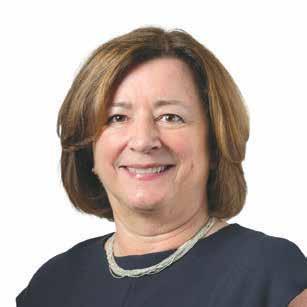
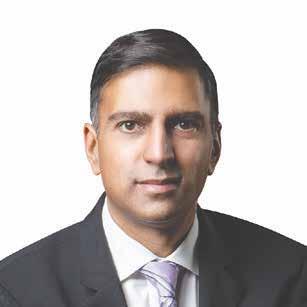
“The ICD Conference is a much-anticipated annual platform for directors across Canada to share solutions to the challenges of modern day directorship, as well as strategies for boards to optimize opportunities.”
Jim Carter, F.ICD
Chair, Finning International Inc. and Careers The Next Generation Foundation; Director, Ellis Don Construction, Brand Safway Industrial Services Ltd.
“Change is constant and unrelenting. It’s our duty as directors to help lead our organizations to understand and adapt to what can sometimes be seismic changes. Attending the ICD National Director Conference will give you a window into critical shifts in the business and governance landscape, and equip you with actionable insights for the boardroom.”
Alice Laberge, F.ICD
Director, Mercer International Inc., Russel Metals, Canadian Public Accountability Board (CPAB)
“The theme of this year’s ICD Conference – resilience – is critical, now more than ever. In an ever-changing and increasingly volatile macro context, resiliency has become a must-have competency for organizations and their boards.”
Irfhan A. Rawji
Founder & Chair, MobSquad; Chair, The Logic; Director, Canadian Western Bank, PBA Land & Developments; Chair, CIFAR; Chair, The Institute for Canadian Citizenship; Member of the Canada Council for the Arts
REGISTER NOW FOR SPECIAL EARLY BIRD RATES AVAILABLE
FEBRUARY 21, 2025




Without a strong oil and gas industry, we’d all get less for our dollar.


















Canadians rely on imports like fresh produce and electronics, and our broader economy depends on exports to other countries. Without oil and gas exports, Canada would run an enormous trade deficit, resulting in a weaker dollar and driving up the cost of imported goods. At a time when life is becoming increasingly una ordable for many, a strong oil and gas sector protects our dollar.















Learn more at cenovus.com




National Director Conference & Fellowship Awards Gala
Today’s Board: Resilient by design.
Today’s boards must be bold, adaptive, and intentional when exercising their oversight of culture, strategy, and risk.
By being resilient by design, the board and their organizations have the potential for greater impact.
